






























































12 100 glorious years: RC Calcutta
A detailed look at RC Calcutta’s rich history of 100 years.
26 Projects and priorities of RC Calcutta
RC Calcutta celebrates its 100th charter year, sharpening its focus on health, hygiene and literacy.
32 Sri Lanka gives hope to special children through the Ayathi Trust
RI President Mark Maloney inaugurates an acoustics centre funded by Sri Lankan Rotarians and a TRF global grant for special children in Colombo.
38 A mini-Kolkata spells magic at Centennial Summit
The HoF at the Centennial Summit was a buzz of activity and a big hit among the participants.
42 When TRF helps Rotarians to create miracles
A TRF-RI team led by incoming Trustee Chair K R Ravindran and Trustee Gulam Vahanvaty shed light on what works and what doesn’t in global grants.
48 Skill youngsters to become agri-entrepreneurs: Venkaiah Naidu
A summary of the Vice-President’s address at the Centennial Summit.
62 RC Bhavnagar celebrates 75th birthday with style & service




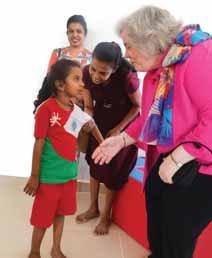

The club celebrates its platinum jubilee with sterling service projects.



66 RC Madras South celebrates 60 years with great projects Remembering the club’s milestone projects on its landmark year. 26


On the cover: At a project site in Purulia where RC Calcutta, RID 3291, is building a residential school for tribal children.



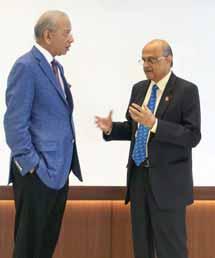





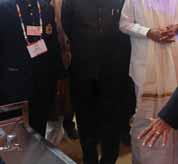
March issue mirrors Centennial Summit
Rajendra Saboo’s views in the article Rotary India honours two of its jewels my opinion on Rotary has taken a U-turn. All the articles and photos related to the Centennial Summit are excellent and interesting to read.
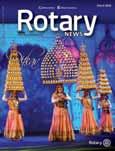
The article A Rotarian persevered, and a teenager walked again is worth reading and my congrats to A N Aiyanna, President-elect, RC Mysore Midtown, for his noble efforts. My hearty regards to Editor Rasheeda Bhagat for coming out with great articles and pictures each month in Rotary News. M A Akbar, RC Mayiladuthurai Kings — RID 2981
TheMarch edition resembles a colourful photo album with beautiful pictures of Rotary leaders and their spouses. Editor’s note on the Centennial year is concise and
Bravo Rotary
I appreciate the bold and humanistic decision of RI President Mark Maloney to cancel the Rotary International Convention scheduled for June 6–10, 2020, in Honolulu, USA, in response to the threat of Covid-19 pandemic. This bold decision is necessary to protect the health of everyone and this move has enhanced the public
the beautiful content gives readers the feeling of being at the celebrations in Kolkata.
An evening with Laxman by Viney Kirpal gives us a chance to remember the legendary cartoonist whose sketches are time immemorial. RIDN A S Venkatesh’s advice to Rotarians to wear their pins is really a good idea and should be complied with as far as possible. Articles like Rotary India honours two of its jewels, Let’s work for a more diverse & flexible Rotary: Maloney, and Honouring generosity among others are worth reading. Keep up the good work.
Philip Mulapone M T RC Trivandrum Suburban — RID 3211
Bhagat’s editorial Rotary India marks its 100th year with a bang, baja and bonhomie
image of Rotary as a caring humanitarian organisation.
R Murali Krishna
RC Berhampur — RID 3262
The article Manipal gets a Rotary Skin Bank in the Feb issue is informative. It’s good to know from Dr Sreekumar, HoD of plastic surgery at the Kasturba Hospital, Manipal, that patients with over 40 per cent of burns
was interesting. It is a fact that no place on earth celebrates Rotary events as colourfully and grandly as Rotarians do in India.
Messages from RID Bharat Pandya and Kamal Sanghvi were informative. The cover story Rotary India celebrates centennial with service projects worth $300 million was excellent. Congratulations to RID 3232 for donating pink autos to 100 unprivileged women and further training 200 of them to drive autos enabling them to become financially independent. Report of Team Rotary News on New light-weight calipers for polio sufferers was superb. Daniel Chittilappilly RC Kaloor — RID 3201
Thereasons listed out by RIDN A S Venkatesh in his profound appeal to Rotarians to wear the Rotary pin wherever they go are truly impressive. The appeal will obviously prompt every Rotarian
(third-degree burns) can be treated from donated skins. The skin of the donors has to be retrieved within six hours of their death and it can be used to cover and heal the burnt area. Also, the donors’ skin can be processed and stored for five years. This is a TRF project and the cost is nearly `80.45 lakh.
N Jagatheesan
RC Eluru — RID 3020
The Feb issue has an impressive message by RID Dr Bharat Pandya in which he emphasised on peace which, he says, cannot be achieved through conferences or seminars but through personal relationships and working one-to-one to eliminate conflict. RID Kamal Sanghvi also acknowledges the need for global peace.
Basic Life Support courses are the need of
to wear the pin and thus become the brand ambassador of the organisation.
Dr B Nagalingam Pillai
RC Nagercoil — RID 3212
Iwashappy to go through the Editorial on the centenary celebrations of Rotary India. RI President Mark Maloney in his message expressed confidence that young people will spur the growth of Rotary in future. He says that it must be our job to support the innovations of the youth which will help grow Rotary. We as Rotarians must do something for the Rotaractors in the years ahead.
The RI directors have focused on Rotary Water Mission 2025 and RID Kamal Sanghvi puts it aptly when he says that “let us tighten our belts, the climb is steep, but climbing must be done.” Two of TRF’s largest individual donors — Rajashree Birla and D Ravishankar — were honoured at the Centennial
Summit in Kolkata and the article Honouring generosity by Jaishree has nicely captured some of the interesting moments at this session.
RC Rajkot has set up a skin bank at a cost of `50 lakh with the support of RC Cary Kildare, RID 7710, US. Good articles on such great Rotary projects are most welcome.
S Muniandi
RC Dindigul Fort — RID 3000
Iliketwo articles in the March issue very much. In the article Business casual , RIPE Holger Knack when asked to list the post he held during the interview for the top RI post says, “I did not hold any position before becoming the district governor and I had no appointment in the district leadership.” But Rotarians knew him for his work in the youth exchange programmes. If a man has skills, then he can get to the highest position.
Secondly RIDN A S Venkatesh shares a good point in Rotarians
must wear their pin always by stating that if all Rotarians in India wear pins when they go out then they become our brand ambassadors. It would be even better when all our members around the world aim to wear their pins.
Pradeep Gandhi, RC Ichalkaranji Central — RID 3170
Formany of us who could not attend the Centennial Summit in Kolkata, the extensive coverage in March issue made it almost live for us. The stunning photos and graphic articles brought out the essence of the whole event for the readers. I must thank the Editor for such a fantastic reporting of this unique, once-in-a-lifetime event. While reading, I felt as if I am participating in that event. It was a pleasure to see RI President Maloney with colourful pagdi and Gay in a saree dancing to Bollywood music.
V G Deodhar
RC Nasik — RID 3030
the hour and must be taught in schools and educational institutions as pointed out by Dr Saritha Rao in the article Simple steps to rescue heart attack victims . It is critical for victims of cardiac arrest and life-threatening diseases to get timely aid before they are taken to hospital for medical treatment. If this course is taught efficiently in institutions,
it will go a long way in saving precious lives.
A very laudable and commendable effort is made by RC Madras in restoring the lakes in Chennai as this will help in preventing water from getting polluted and it is also a step towards sustainable development.
Naveen R Garg
RC Sunam — RID 3090

RI Convention cancelled
In response to the ongoing COVID-19 pandemic, RI has cancelled the annual convention scheduled for Jun 6–10, 2020, in Honolulu, Hawaii, USA. RI President Mark Maloney has shared that this is the right and necessary decision to protect the health and safety of convention attendees, Rotary staff and the Honolulu community.
For more details, visit riconvention.org.
We welcome your feedback. Write to the Editor: rotarynews@rosaonline.org; rushbhagat@gmail.com Click on Rotary News Plus in our website www.rotarynewsonline.org to read about more Rotary projects.

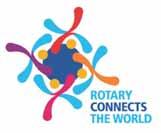
Ispenda lot of time thinking of family, not just my own or the extended family of Rotary, but also the families we are helping in the communities we serve. In many parts of the world, mothers and children face challenges to survive that most of us will never comprehend. According to the World Health Organisation, the risk of a woman in a low-income country dying during pregnancy or childbirth, or from related causes, is about 120 times higher than that of a woman living in a high-income country. It is encouraging that infant mortality rates are declining globally, yet 4 million babies annually still die within the first year of life.
In April, Rotary turns its attention to maternal and child health. And when we think of what we can do to help, we can look to clubs like the Rotaract Club of Calabar South-CB, Nigeria, for inspiration. It teamed up with the Rotaract Club of Canaan City (CB) in a program focused on educating mothers on best practices to prevent infant mortality and promote postnatal health for themselves and their babies. In Bangladesh, the Rotary Club of Dhaka North provides free surgeries and medicine to pregnant women who cannot afford the hospital costs associated with giving birth. I encourage you and your club to go to ideas.rotary.org to find projects like these that are helping to save mothers and children.
We also have witnessed how millions of people — families and entire communities — have been ripped away from their homes because of conflict, poverty, and disasters during the past decade. But Rotary has not stood idly by during the global refugee crisis. During Rotary Day at the United Nations last November, we honoured a Rotary Peace Fellow and five Rotarians who are taking action to help refugee communities. Among them was Ilge Karancak-Splane of the Rotary Club of Monterey Cannery Row, California. After visiting several tent camps in Turkey, she led a Rotary project that collected 1,000 pairs of children’s shoes and socks for families in the camps and, later, led a global grant project to help educate refugee children. In March, Gay and I had the privilege of visiting a tent
Rotarians from Turkey and California were accomplishing with Syrian refugees.
The challenges faced by mothers, their children and refugee communities around the world are daunting. But when we remember our greatest strength — how Rotary Connects the World — we can begin to find solutions. Through our creativity, our resources, our dedication and our networks, Rotary can and will open opportunities to face these challenges.
Mark Daniel Maloney President, Rotary International

take control too
happened to be in Mexico City and watched with fascination and admiration the call given by a collective of Mexican women’s associations to observe this year’s International Women’s Day (March 8) by simply disappearing from public places — offices, public transportation, grocery stores, restaurants, shopping malls... everywhere. They decided to do so to protest against the growing culture of violence against women.
Considered a landmark protest since the #MeToo movement, Mexican women chose this unique form of protest to show their frustration and anger at what they considered was their government’s apathy to increasing violence against women. In recent years, Mexico has seen a huge increase in gruesome violence against women, including murder and rape. Recently, a 7-year-old girl’s naked body was found in a polythene bag. In another instance, a woman was killed and partially skinned, allegedly by her own husband.
Mexico has an estimated 21 million registered women workers and it was heartening to watch the huge support that this initiative got from government organisations, banks, educational institutions and corporates… all of them publicly supported this call given by feminists to Mexican women “to simply disappear for one day”.
As I read this novel form of protest and what the women in Mexico faced in their daily lives, a chilling similarity emerged between Mexico and India. Apparently in Mexico, one-fourth of the women who are killed breathe their last in their own homes. Sadly, even in India, don’t we see girls/women being subjected to gruesome violence in their own homes… be it through female foeticide, as proved by our falling sex ratio, or dowry-related violence, wife beating etc. How many times have we heard women activists/researchers tell conference after conference that “the Indian home is not a safe place for women”?
But the silver lining is that as in Mexico, in India too, women have now decided that enough is enough and they will no longer keep quiet. The Nirbhaya rape case worked on the collective psyche of Indian women, and men as well, and the outrage erupted through angry protests, which ensured that the criminal justice system sprung into action, the criminal rapists were apprehended, tried and hanged on the very morning I wrote this editorial.
On the day the Mexican women decided to “disappear”, corporate offices, restaurants, malls etc ended up being mere shadows of their normal selves, and the women did manage to send out a strong message that women, their dignity, their safety, their lives… they do matter.
It reminded me all over again of one of my most favourite poems… Phenomenal Woman by Maya Angelou. Yes, we women are indeed phenomenal. The Rotary family has many, many of them. They stand side-by-side of male Rotarians, lend a helping hand, a generous heart, and loads of both compassion and commitment, sometimes taking leadership roles too, to improve the lives of the less privileged. During these tough times, when COVID-19 has turned the entire world topsy-turvy, the resolve, commitment, restraint, control and compassion that women can bring into anything, are required more than ever before.
How often have you seen in your own homes that in a crisis, it is the woman who keeps her sanity and holds the family together? This crisis too will pass, and all of us, men and women, who navigate the tough terrain ahead, will emerge better human beings… for this virus is reminding us once again what our priorities should be… good health, clean air, better hygiene and sanitation, responsible behaviour, and above all, a thought for our fellow human beings and other forms of life on our planet.
Rasheeda Bhagat
RI Dist 2981
RI Dist 2982
RI Dist 3000
RI Dist 3011
RI Dist 3012
DG N Manimaran
DG Natesan A K
DG Dr A Zameer Pasha
DG Suresh Bhasin
DG Deepak Gupta
RI Dist 3020 DG M Veerabhadra Reddy
RI Dist 3030 DG Rajendra Madhukar Bhamre
RI Dist 3040 DG Dhiran Datta
RI Dist 3053
RI Dist 3054
DG Harish Kumar Gaur
DG Bina Ashish Desai
RI Dist 3060 DG Anish Shah
RI Dist 3070 DG Sunil Nagpal
RI Dist 3080 DG Jitendra Dhingra
RI Dist 3090 DG Rajeev Garg
RI Dist 3100 DG Hari Gupta
RI Dist 3110 DG Kishor Katru
RI Dist 3120 DG Sanjay Agrawal
RI Dist 3131 DG Ravee Dhotre
RI Dist 3132 DG Suhas Laxmanrao Vaidya
RI Dist 3141 DG Harjit Singh Talwar
RI Dist 3142 DG Dr Mohan Chandavarkar
RI Dist 3150 DG Pandi Sivannarayana Rao
RI Dist 3160 DG Nayan S Patil
RI Dist 3170
RI Dist 3181
RI Dist 3182
RI Dist 3190
DG Dr Girish R Masurkar
DG Joseph Mathew
DG Ramesh B N
DG Dr Sameer Hariani
RI Dist 3201 DG R Madhav Chandran
RI Dist 3202
RI Dist 3211
RI Dist 3212
RI Dist 3231
DG A Karthikeyan
DG Shirish Kesavan
DG S Sheik Saleem
DG Sridar Balaraman
RI Dist 3232 DG G Chandramohan
RI Dist 3240
DG Dr Debasish Das
RI Dist 3250 DG Gopal Khemka
RI Dist 3261 DG Ranjeet S Saini
RI Dist 3262
DG Debasish Mishra
RI Dist 3291 DG Ajay Agarwal
Printed by P T Prabhakar at Rasi Graphics Pvt Ltd, 40, Peters Road, Royapettah, Chennai - 600 014, India, and published by P T Prabhakar on behalf of Rotary News Trust from Dugar Towers, 3rd Flr, 34, Marshalls Road, Egmore, Chennai 600 008. Editor: Rasheeda Bhagat.
The views expressed by contributors are not necessarily those of the Editor orTrustees of Rotary News Trust (RNT) or Rotary International (RI). No liability can be accepted for any loss arising from editorial or advertisement content. Contributions –original content – are welcome but the Editor reserves the right to edit for clarity or length. Content can be reproduced, but with permission from RNT.
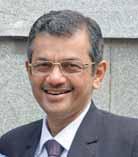
The COVID-19 pandemic has brought to fore the critical importance of a different approach to healthcare and socialising as we know it. Healthcare even in the most advanced countries is focused on individual healthcare. We now have to think about public healthcare, especially in an outbreak situation. In epidemics the issue is the high number of patients who arrive at hospitals all at the same time. This can have a negative impact on healthcare systems, which are not used to coping with these kinds of numbers every day. Adapting to this is not easy. A complete change of approach is needed. We have to practise ‘physical distancing’ not just now but for a long time to come. And the way we travel will change forever. This will also change the ways Rotary clubs function and the way we organise events and fellowships. These are unprecedented challenging times. But districts and clubs in our zones are doing well, adapting to the change. Many districts are organising training events online and clubs are holding meetings on Zoom. This could be a good way forward to attract young professionals and women into Rotary’s fold. April is Maternal and Child Health month. Women and children suffer the greatest burden from disease globally. Diarrhoea and pneumonia are the largest killers of children under five. Women lack access to healthcare in many parts especially during pregnancy. Through Rotary we provide critical vaccines that protect against childhood illnesses, we combat chronic malnutrition; and through our VTTs for maternal health in various parts of the world we have been able to sustainably reduce maternal mortality. By doing all this and more we ensure better access to information and healthcare to women and mothers so that they can plan for healthier families and in turn promote economic well-being.
Every year over 300,000 mothers die from complications around pregnancy and childbirth in the world; 30,000 of these maternal deaths are in India. India accounts for 10 per cent of all maternal deaths worldwide. Apart from medical reasons like postpartum haemorrhage, hypertension and others an important cause is illegal abortions and unintended pregnancies, particularly among adolescents. Out of every 1,000 children born 22 do not live up to one month of age and 31 do not live up to one year. All these can be prevented by a multi-pronged approach including education, nutrition, access to affordable healthcare, safe water, proper sanitation and hygiene and timely treatment for mother and child. Through Rotary we have the opportunity to truly Connect the World with the message — Every mother is important, every child counts.
Enjoy Rotary, Enjoy Yourself.

Dr Bharat Pandya RI Director, 2019–21
“When the going gets tough, the tough get going,” is an old saying.

It’s a time of great stress and uncertainty. It’s also a moment in time when the work we’re doing is most critical. We Rotarians play a great role in the global crisis of COVID-19, both during the crisis and after it is over.
Do your bit by ensuring and advocating social distancing, the only known way to avoid getting this virus. In the coming days, our job will be extremely important to serve the community that has been battered mentally, physically and financially. I would urge the clubs and Rotarians to help in all ways possible.
An estimated 5.9 million children under the age of five die each year because of malnutrition, inadequate healthcare, and poor sanitation — all of which can be prevented by providing immunisation and antibiotics to babies, access to essential medical services, and support to trained healthcare providers for mothers and children.
Please make high-quality healthcare available to vulnerable mothers and children so they can live longer and grow stronger. It bears repeating that women are central to healthy families, and ultimately healthy communities, and children are the future of any nation.
Recently I was in Raipur to inaugurate an operation theatre and ICU at the Sri Sathya Sai Sanjeevani Hospital. I commend the members of RC Raipur Greater for curating this immense humanitarian project for “saving little hearts” — surgeries for children with congenital heart diseases. I congratulate PDG Harjit Singh Hura and DG Ranjit Saini for their resolve to see this through.
Sri Sathya Sai Hospital performs these surgeries free of cost and to aid them in this noble cause, I gave a clarion call to the Rotarians of the district to partially sponsor the surgeries with a cash contribution of Rs 25,000 per child. The Rotarians responded magnanimously and over 300 surgeries were instantly sponsored. A whopping `75 lakh was raised in 10 minutes.
It is projects like these which strengthen my belief in the capability of Rotarians to do good in the world.
God bless and Godspeed.

Kamal Sanghvi RI Director, 2019–21
Board of Permanent Trustees & Executive Committee
PRIP Rajendra K Saboo RI Dist 3080
PRIP Kalyan Banerjee RI Dist 3060
RIPN Shekhar Mehta RI Dist 3291
PRID Panduranga Setty RI Dist 3190
PRID Sushil Gupta RI Dist 3011
PRID Ashok Mahajan RI Dist 3141
PRID Yash Pal Das RI Dist 3080
PRID P T Prabhakar RI Dist 3232
PRID Dr Manoj D Desai RI Dist 3060
PRID C Basker RI Dist 3000
TRF Trustee Gulam A Vahanvaty RI Dist 3141
RID Dr Bharat Pandya RI Dist 3141
RID Kamal Sanghvi RI Dist 3250
Executive Committee Members (2019–20)
DG Deepak Gupta RI Dist 3012
Chair – Governors Council
DG Nayan Patil RI Dist 3160
Secretary – Governors Council
DG Dhiran Datta RI Dist 3040
Secretary – Executive Committee
DG Ajay Agarwal RI Dist 3291
Treasurer – Executive Committee
DG Rajendra Madhukar Bhamre RI Dist 3030
Member – Advisory Committee
ROTARY NEWS / ROTARY SAMACHAR
Editor Rasheeda Bhagat
Senior Assistant Editor Jaishree Padmanabhan
ROTARY NEWS / ROTARY SAMACHAR
ROTARY NEWS TRUST
3rd Floor, Dugar Towers, 34 Marshalls Road, Egmore Chennai 600 008, India. Phone : 044 42145666 e-mail: rotarynews@rosaonline.org Website: www.rotarynewsonline.org
Now share articles from rotarynewsonline.org on WhatsApp.

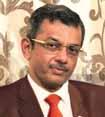
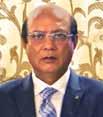
Dear Rotary leaders,
In view of the COVID-19 pandemic and keeping in mind that the health and safety of our Rotarians and Rotary families are of paramount importance, it is prudent and recommended to postpone, rework or cancel Rotary events including conferences, training events, intercity meets, seminars and Rotary meetings. Wherever possible they may be held online.
The RI Board is fully supportive of this and encourages district leaders and incoming district leaders to give full and proper consideration to this keeping in mind the advice and directives of local health authorities and the government.
The OCVs (official club visits) for current year may be continued as per the discretion of individual district governors.
Do not share or promote unconfirmed messages. Please follow instructions and recommendations of the government/local health authority.
Stay healthy, stay safe.
Regards,

Dr Bharat Pandya RI Director, 2019–21

Kamal Sanghvi
RI Director, 2019–21
Rasheeda Bhagat
It has a lineage, pedigree and a hoary past that will not be easy to match by any Rotary club in the world. Did you know that the Rotary Club of Calcutta, RID 3291, which completes 100 years this year, played a role in getting the Howrah Bridge over the River Hooghly being constructed? Not only that, for long after this, one of its club members was on the government committee formed for the upkeep of the bridge.
The club had the honour of being addressed by none less than Mahatma Gandhi, and though memories are hazy about what exactly he said, there is one comment that is quoted over and over again. Apparently all the bada sahibs of Calcutta, who were the members of this prestigious club, agreed to their luncheon meeting being an entirely vegetarian one, in honour of the vegetarian Gandhi. And the Mahatma said (undoubtedly with that famous twinkle in his eye), “I notice today the Rotarians are eating a Bengali widow’s luncheon!”
Also, as past president Ritwik Gupta told Rotary News, a million dollars were donated through two $500,000 cheques, to the Missionaries of Charity, even after Mother Teresa’s death by an “American woman, who I think was the wife of a Rotarian. She gave the cheques for two successive years and insisted that RC Calcutta hand it over to the charity. Later, Sister Nirmala, who headed this
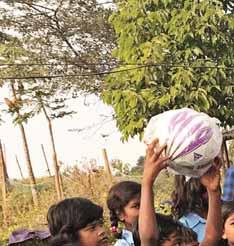
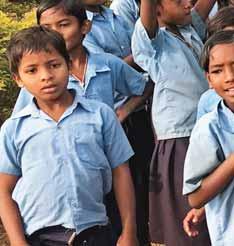

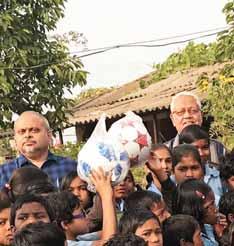
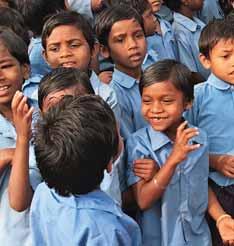

charity, said that we are getting enough donations from other sources too, so please ask this lady to give the money to other charities too.”
As Rotary across India gets enthused to celebrate the 100th year of Rotary in our country, at the celebratory event planned on New Year’s eve by the club there is music and dance, food and fun. I manage to talk to some of the illustrious past presidents of the club such as Gupta, PDG Prabhat Rohatgi,
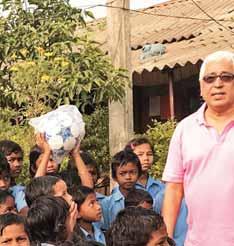
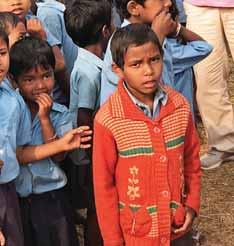

Dr S K Sharma, Nilima Joshi, and of course the present club president Purnendu Roy Chowdhury.
This is the club that also wears the proud label of sending the first RI President from India in Nitish Laharry, who became a member in early 1926, and within a year went on to become its first Indian secretary. The club’s history book describes him “as a quiet and even a shy young man” who got into the thick of Rotary right “from the start and



The way the villagers accept what we Rotarians gave, showed they valued our help… a single blanket was a big deal to them.
Amit Ghosh, club member
during his first two years as a Rotarian, apart from being secretary, initiated a Rotary Education Committee, formed by the nucleus for a club library and edited The Chaka,” the club bulletin.
As I ride in club member Amit Ghosh’s car from the airport to the inaugural of a club project — gifting a camera worth `25 lakh to a local hospital for preventing blindness in premature babies — he talks about how he got “Rotary service” injected into his blood. Barely four years ago, as the head of finance in a Tata company, “I could walk into the room of the joint secretary, Ministry of Steel, by just waving my Tata Steel ID, saying I want to negotiate for this subsidy or that. But going to a village in the Sundarbans and distributing dictionaries to the schoolchildren, my eyes opened to the fact that people also live like this. And everything is not related to the North Block or some hi-fi bank in Mumbai.”
That single experience gave the man who has held the post of CFO in various Tata group companies, “the
RC Calcutta President Purnendhu Roy Chowdhury (far left) and Centennial Committee Chairman Saumen Ray (R) with tribal children of Santhali in Purulia. A boarding school is being built here by the club to accommodate 400 young students.

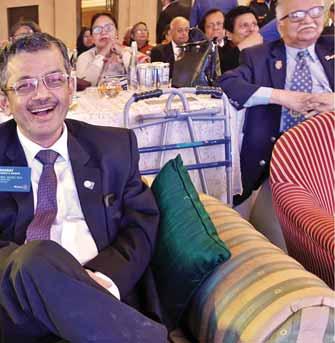
Oneof the oldest living members of RC Calcutta, 86-yearold PDG Prabhat K Rohatgi, who has sponsored the Centennial Bell, on the eve of RC Calcutta’s marking of its 100th charter day, takes me down memory lane on the club’s hoary past.
He became DG in 1998–99; “actually for a long time I refused to be a Rotary office holder. But as a Rotarian I found that what many Rotarians lacked was basic knowledge — what they could get out of Rotary and what they could give to Rotary.”
He found that many people joined Rotary, stayed for a while, found nothing to satisfy them and left. “That was happening, and RI was very worried. So I said let us put together an interesting training programme or a course
to train our Rotarians, who were interested, about what is Rotary, its rules and regulations that they should conform to, and which in return, would give them a lot of benefit.”
Thus was born RLI or Rotary Leadership Institute, which offers 3–4 different courses every year and about 150–200 Rotarians get trained through these courses every year. “In 10 years, I can say, RLI must have trained about 2,000 Rotarians who know something about Rotary. Every now and then I have people calling up to say thank god I did the course.”
Now there are three courses and “RI has accepted RLI as an educational adjunct. It’s not part of Rotary but an adjunct of RI, and is known for giving the right kind of Rotary information.”
idea of real India… and the value one dictionary, or one solar lamp or mosquito net, has for many people. The way the villagers accept what we Rotarians gave showed they valued our help… a single blanket was a big deal to them,” says Ghosh.
In the Sundarbans, “we have multiple projects, it takes 5–6 hours to go there from Kolkata, two hours by car and another three or more hours by river.”
Totally hooked to the service projects of his club, he talks about a PHC (public health centre) where RC Calcutta has given a lot of medical equipment and “solar power for the refrigerator where our polio drops are stored. And once you give one person or organisation solar power, the question comes why not to another.”
But isn’t there electricity available in a place not that far from Kolkata, I ask him. “Yes, the power line is indeed there, but with that electricity, a 100watt bulb burns like a mere candle,” he says. There were two higher secondary schools in the village without power, as well as a police thana which the
Rotarians have lighted up. “Last year, when we visited the police station, chai cups were immediately offered. Thanks to our solar power, you can see the police station right from the river and the policemen told us because of the huge glass lantern that burns there, the crime rate has fallen in that small village. This is the impact of electrification,” says Ghosh.
In another village in the Sundarbans, along with a German club and a global grant, RC Calcutta has put up a night shelter for the family members accompanying pregnant women coming for delivery. “In these villages full-term pregnant women come first on a bullock cart and then through a river to the PHC, which has a labour room and a room for the mother and newborn made of RCC sheets.” But the persons accompanying her, the husband and other children who also come along, had earlier no place to sleep. Apart from the night shelter, the club has installed LED bulbs and facilities for autoclaving the surgical equipment. All of this is solar powered. Next on the club’s list is giving incubators for premature babies…
Only when you have been there as a good member for three years, and get involved, you will never leave Rotary!
Prabhat Krishna Rohatgi Past District Governor
“I simply love the projects-part of being in our club,” gushes Ghosh.
Well, which member doesn’t, I wonder, as I interview a group of illustrious past presidents of the club, all of whom have left an indelible mark on this 100-year-old-club.
I ask past president Ritwik Gupta, a member of RC Calcutta for 33 long years, who led the club in 2014–15, how difficult was it to serve as president in a club which has so many notable projects going. “Not difficult at all… it just took everything from me,” he smiles. “You just give yourself for one year to your club, that is not difficult!”

PDG Prabhat K Rohatgi is more senior than him, having joined the club in 1958, when he was only 26, and is considered a “living legend” in the club. He joined Rotary “because in our family Rotary was held in high esteem.” His father too was a president of the club. Initially, the young man wasn’t very comfortable to be in a club “full of seniors and uncles,” but soon embraced Rotary so much that his wife Shashi loves to introduce herself as his “second wife”; the first one being Rotary.
Now set to become the president of her club, RC Calcutta Victoria, she complains that for a long time he did not allow her to join Rotary and his club. Asked why, Rohatgi smiles and says: “Because only one rickshawman pulls a rickshaw.”
This veteran has “very many memories” of Nitish Laharry. “A short while after my induction, I got a call from Laharry — he was called Ned Laharry — who said I want to talk to you.”
So Rohatgi went to his office which was on the first floor of Metro cinema “which has now become a clothing store. He was a very interesting character. How many people know that he was virtually the father of Bengali cinema and a distributor of Hollywood films? And he helped so many producers. He had a very vast knowledge of world affairs, and was a real pioneer in Rotary.”
Rohatgi became club president in 1989–90; 30 years hence, what kind of challenges does a younger man like Purnendu Roy Chowdhury, the present incumbent, face today?
“The biggest challenge is getting the Rotarians to participate. He has got members alright but not all of them have the kind of passion that is necessary.” That passion, says Rohatgi, does not come during the first one or two years of membership of any NGO. “Only
So what was it like to be a Rotarian then and what has changed, I ask a couple of past presidents of the Rotary Club of Calcutta on the eve of its 100th birthday.
“Well, the camaraderie is not the same anymore,” says past president Ritwik Gupta.
PDG Prabhat Rohatgi, a club member for 61 years and known as the “living legend” in his club, pauses, sighs and says: “Lots has changed; but what is most striking is that just like in our larger society today, where even close relations are not that close today, because the joint family system has broken up, this is true of Rotary too.”
Striking a nostalgic note, he continues, “In those days, Rotary was like a small village and everybody knew everybody else. It was sort of taken for granted that your joys and sorrows would be shared. Such as… what happened to your child, did he do well in the exams? We knew the children’s names too, and stood by their side through thick and thin. That’s not there anymore today… I wouldn’t say totally, but…”
For example, he says that he still has friends from the earlier years, who were members of RC Calcutta and now live in Mumbai. “We are
still in touch. But the ones who came 10 years back and would have left or migrated to another city, don’t even remember me.”
Asked to define the positives in today’s Rotary, compared to 40–50 years ago, he says without a moment’s hesitation. “Undoubtedly, service projects; we do them today on a much bigger scale. We were planting 500 trees and thinking we had done the world good. Today that number is not 5,000 but 20,000.” He gives credit for this change in mindset and bigger service projects to “The Rotary Foundation. TRF has been one of the biggest contributors to our thinking big projects. When I became a DG, I was worried that barely 4 to 5 clubs in my district were having the knowhow to do matching grants.”
He recalls that in Nepal the previous year the district had provided 20 cycle rickshaws and that was thought a big thing. “In my year I said we have to do a much bigger project and give 500 rickshaws.” But the question was where to get the money, and bang came the answer — a matching grant! “That was the first matching grant we did in this part of the world and that was during my year.”
when you have been there as a good member for three years, and get involved, you will never leave Rotary!”
Purnendu Chowdhury says today RC Calcutta has many young members and they can’t be told to do this or that. So his foremost effort is to involve and engage them through both fun and fellowship meets and parties and then draw them into the club’s service projects.
Shooting straight from the hip, I articulate what is being whispered in some of Kolkata’s Rotary circles. Is your club a snooty or arrogant one, saying we won’t take this member or that one?
Answers Chowdhury, “Not snooty or arrogant, but yes we are very choosy about who we take. Because we don’t want anyone to come and start his or her business here. If we were snooty, we wouldn’t have been at 245 members!”
The norm, he adds, is that “you have to be a somebody to be a member of our club and not join it to advance your business. If I want an insurance service, I will call the top insurance guy

who is a member of my club and get it done. But he should not chase me for his business.”
Asked how welcoming RC Calcutta was on women’s membership, he answers: “Very much, we have inducted many women members and they are happy to be part of our club; their membership is around 10–12 per cent. And we’ve had two women presidents — Nandita Sen and Nilima Joshi. And our club secretary this year is Anusua Das.”
Memories are many, as is nostalgia. Rohatgi vividly remembers the club meeting addressed by the Dalai Lama, which went on beyond an hour of the stipulated time. “There was pindrop silence when he spoke, and nobody walked out of the hall. He had such magnetism. The same was true of Field Marshal Manekshaw, such a captivating speaker, and he talked very highly of Rotary.”
Did Rabindranath Tagore ever address their club? “Not to my knowledge. This was a very elitist club, not in a negative sense but because the
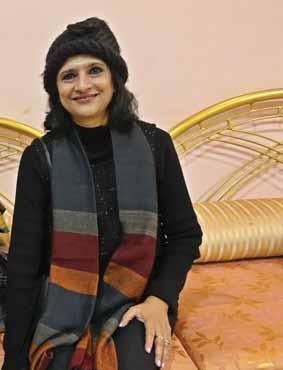

Madhavi Pandya with past president Nilima Joshi.
best doctors, chartered accountants, lawyers, etc were members of our club. Even then we did village uplift programmes and it was so interesting to watch all those top people doing hands-on service.”
He recalls that in the 1950s, one of the early projects RC Calcutta took up was the Garcha basti improvement. “It was then a slum area, and was also the home of Laharry. Bengal then had many Naxalites and they had a strong presence in the basti area, where we had planned the inaugural of a homeopathy dispensary. Suddenly they came with swords, daggers and sticks at us. And who should drive them back? The Rotaractor — now a Rotarian — heading our Rotaract club.
He and his Rotaractors drove those people out!”
Those were exciting days when topmost professionals did hands-on service. Today too, top professionals from different sectors are there, “but they don’t want to go to a village, say for a medical project. They will send their assistants… but in the olden days every Sunday we would be there. That is something that has changed, people come here today to become our club members to improve their stature in society.”
Recalling the Begumpur and Garcha basti uplift projects of yore, for which the club got a special award from Rotary International, he says, “It was a holistic project, we put up new looms
as there were many weavers in the area. We also introduced sericulture there. It used to be like a grand picnic, we had fun, our Anns and children went with us in our cars. We talk about inclusiveness and involving our families in Rotary these days, but all that existed in the earlier years.”
Also, even before he joined Rotary in 1958, “Rotary had a certain status in the system and the province. That is why and how our club could be involved in the building of the Howrah bridge.
At that time, he explains, there was a pontoon bridge which would open up for the passage of ships. RC Calcutta lobbied with the government for a bridge at that point and “Rotary
had a representative in the committee to look after the maintenance of the bridge which was then called the New Howrah bridge and for years together, till either the club lost interest or our representative didn’t turn up, he continued on that committee!”
Also, adds Rohatgi, in the earlier years either a Commissioner of Police, an ICS officer or other government officers were members of the club as well as politicians. Adds Gupta, “Surendranath Banerjee, one of the founder members of the Congress, was an honorary member of our club and attended club meetings.”
Past president of the club Dr S K Sharma, who joined RC Calcutta 30



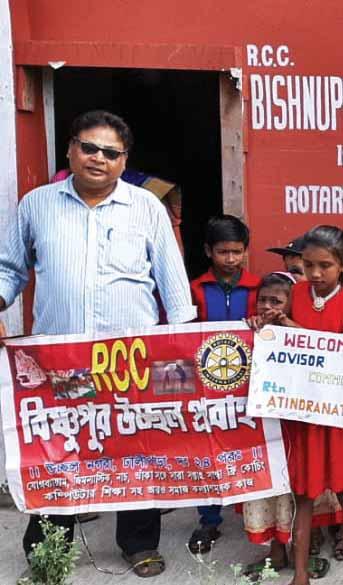
Above: Club President Chowdhury with club members at a school in Bishnupur where new classrooms were constructed.
years ago, shares his seniors’ excitement about dirtying their hands in the mud, while executing service projects. Asked what he enjoyed the most about his three decades in the club, he says, “Helping people, looking after children, patients with heart diseases and so on.”
Incidentally, the first WASH project in Mityanagar in Shantiniketan was financed by Sharma. Says Ritwik Gupta, “He did that when we were distressed to find that those women were forced to go out into the open. We also gave solar lights.”
Only two persons in the area agreed to give “space in their homes for us to build toilets. Two months later, others said they wanted toilets too, specially

the women. Dr Sharma’s wife, Vijayalakshmi was very kind and had a soft spot for this project, and the couple helped to expand it.”
Over the earlier decades the club had a “very good relationship with the government. Actually, we were helping the government, and but for us Rotarians, polio would not have been eradicated from India.”
Interestingly, around 1999–2000, when the club invited the then West Bengal Chief Minister Jyoti Basu as a speaker, the Rotarians weren’t amused to hear him say “I’ve heard you people do a lot of good work.” They felt it was his business to know they did good work!
Sharma talks with passion about the villages that they have renovated, providing solar lamps, hand pumps, toilets for homes, refurbishing schools and giving furniture, books, etc to schools. “Every time we did this in one village, people from the next one would come and request us to help them. To cut a
We are very choosy about who we take. Because we don’t want anyone to come and start his or her business here.
Purnendhu Roy Chowdhury Club President
long story short, we have worked thus in 100 villages in 100 years.”
Adds Rohatgi, “PRIP MAT Caparas from Philippines, who brought in the RCC concept, had said that once you bring up a village to a level where they can look after themselves, leave that village, and go to other villages. We did just that.”
Gupta says that in those early years, the club had “conceptualised an overall village development programme, giving them not just one or two things, but a complete package including health care, water and sanitation, vocational
skills and an income stream. We have set up 10 RCCs, and President Caparas inaugurated one of them. They are very active. Apart from village development, we do a lot of health camps, support hospitals, give a lot of equipment, and so on. We are very proud of the rich history of our club.”
Nilima Joshi, a chartered accountant, is the second female president of the club (2016–17). She joined in 2001, when “there were very few women in our club. And I got to do so many things, making arrangements, taking on responsibilities… I am grateful for all the opportunities that were given to me. Three years after joining I was made a club treasurer!”
So how difficult was it to become club president? “Actually, people were badgering me for at least a few years to become president, but as my children were entering college, I delayed it!” Ask her what she loves about being a Rotarian, and she beams and says, “Everything! The work, our Tuesday

meetings, our projects… particularly the paediatric heart surgeries. When we meet the parents, they are so grateful for what we have done and give us so much love and respect.”
With pride she points out that during her year, RC Calcutta got a huge trophy for being the best club in the district… “we must have got at least 20 awards! We did a lot of work in school education and literacy, and gave e-learning kits. We still get letters from those who have used it.”
Nilima recalls that when they went to villages for adult literacy, “when we asked people do you have toilets at home, most of them looked the other way. And the women were fantastic as they dared their husbands, who beat them, or mothers-in-law who stopped them, to come for adult literacy classes. The primary motive was that this will help us do something for our children; if we learn, we can teach them.”
done by one of their RCCs, which has left an indelible impression on his mind.
The women were fantastic as they dared their husbands, who beat them, or mothers-in-law who stopped them, to come for adult literacy classes.
Nilima Joshi, past pesident
Club Secretary Anusua Das, who runs an engineering company, and joined the club in 2003, says she loves the challenge “of this position in such an important year as the Centennial. So many people have worked so hard to bring the club here; now it is our turn to take it forward.”
Over 100 years, generations of Rotarians in RC Calcutta have touched and changed forever lakhs and lakhs of lives. What is heartening is that the present continues to be great too. Amit Ghosh tells me about the great work
Among the skill development done by RCC is a beauty course. He recalls that in a village in Shantiniketan, while distributing blankets, he met a young Muslim woman who had undergone the course. But she was not allowed to work in a parlour and so he asked her how she made a living. “She said she had her own business; I make house calls around the Idd season. I go out at 7 am and return only at 9 pm. I have so much work.”
During that period, she earned around ` 20,000. When asked how she commutes, “she pointed to a man waiting nearby with a two-wheeler and said, ‘He is my husband; he takes me around.’”
The best part… “And that twowheeler has been bought with my money,” she added!
Designed by Krishnapratheesh S
Clifford A Randall
Lead, kindly Light, amid the encircling gloom; Lead thou me on! The night is dark, and I am far from home; Lead thou me on!
With these words of verse Nitish C Laharry concluded his final address to the international Convention in St Louis, Missouri in June, 1963. They were familiar words to those close to Nitish. He used them frequently.
The “home” he contemplated when he spoke these lines was not the place he called his abode at any time. Nitish was an intensely spiritual man. It was his nature and his instinct to identify the spiritual motivation which he conceived to be at the root of man’s activity and, in particular, those activities attributable to a man’s affiliation with Rotary.
This quality of the man who was the first President of Rotary International from Asia impelled him to challenge Rotarians of the world to “Kindle the Spark Within.” In his words, “By doing so we shall realise that the path to an ultimate destiny lies in the resignation of the fact that all humanity is one and that each one of us is a spark from the Divine Godhood.”
The 52 nd RI President was born in Calcutta and educated there. He was well educated. He received a bachelor of arts with honors in English from the University of Calcutta, also a master’s degree in economics and political science and a law degree. After practising law for four years
he turned to the rapidly growing motion-picture business, in which he spent the rest of his working life. In 1926 he became a member of RC Calcutta under the classification “MotionPicture Distributing.”
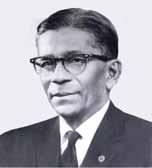
A history of the Calcutta club contains this note about Nitish: “He was appointed the first Indian Secretary of the club. Although at that time the writer knew him as a quiet, even shy, young man he was in the thick of it right from the start.”
Eighteen years later he became President of RC Calcutta, and 18 years after that he became RI President at Tokyo, Japan. Quiet, modest, sensitive and humble he has always been, throughout the 38 years he served Rotary. Yet he has always been “in the thick of it.” Space permits but one example: his part in the 1958 Asia Regional Conference held in New Delhi.
Nitish served as Chairman of that Conference described by informed men of India as the largest non-political, non-religious gathering of Indians ever held. I accompanied Nitish on a visit to the late Prime Minister Jawaharlal Nehru prior to the opening of the conference, and we invited him to join the Rotarians at a garden party closing the conference. It was a gesture of courtesy. We scarcely expected Mr Nehru would find it possible to
attend a social function devoted to Rotary fellowship. However, when the garden party was its peak with 2,000 Rotarians and members of their families in attendance, Prime Minister Nehru walked into the garden, alone and unescorted, greeted the Rotarians, and joined in the conversation. It was a dramatic event and many interpretations could be placed upon it. I had my own interpretation. I felt quite certain that Nitish had indeed kindled the spark on his fellow countryman Mr Nehru, and that the Prime Minister, with equal sensitivity, was giving personal recognition to Nitish for his service, devotion and diligence.
At a time, in the evolution of Rotary, when the age-old distinctions between East and West were coming into ever sharper focus, Nitish Laharry came and walked among us as our leader. He was the living example of the fact that in truth East and West can meet. He was an inspiring symbol of his own deep belief in “the essential oneness of mankind.” And now has gone to walk with the Master. Let us all give thanks for what he was and what he gave to us. Let us reverently rejoice that the kindly Light has led our Nitish home.
The writer is past president of Rotary International (1958–59).
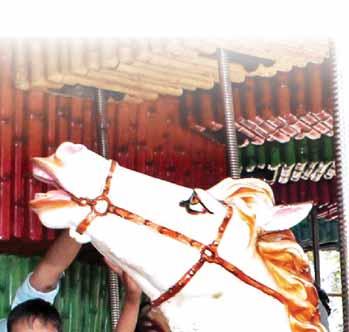
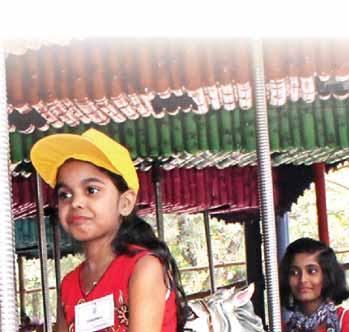
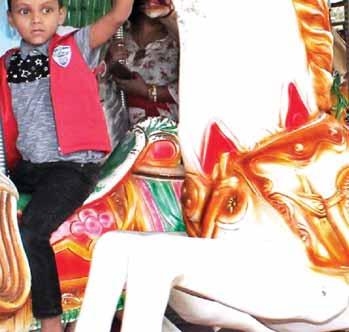


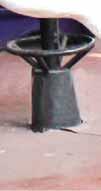
One of the most iconic and probably the longest lasting Rotary project in the world is Children’s Treat that the Rotary Club of Calcutta, RID 3291, has been doing for 95 years.
PP Ritwik Gupta, who has been deeply engaged in bringing out an updated version of the club’s history, talks with passion about this signature project of his club, which was what got him into Rotary in the first place; he joined the club in 1987.
Over a steaming cup of chai on a freezing New Year’s eve, as his club turns 100, Gupta says: “My father was a Rotarian and a member of RC Calcutta and it was from his office that a lot of work on the Children’s Treat project was being done. The person there with him was about my age; I told him you are doing this wonderful thing, why can’t I be a part of it? And he said, join us! So I told my dad I want to join your club. He talked to a Rotarian and that man took me under his wing from Day 1”
The chance to “serve, right from Day 1, keeps you inspired,” he says, adding casually: “By the way,


Children’s Treat started in 1925 — RC Calcutta was formed in 1920 — and we just had the 95th session of the project earlier in December. Only during World War II, when there was a blackout, one session was missed.”
It all began, when on a Christmas day in 1925, says PP Ritwik Gupta, a few Rotarians from their club noticed
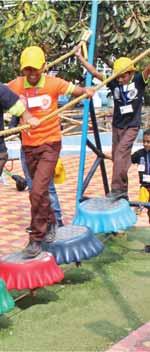
some poor children begging on the streets and thought we have to do something about this. “Within a few days, they got together some children, don’t ask me from where, and gave them a day of sunshine, and we’ve never stopped doing that!” Thus began the club’s signature project Children’s Treat.


So during the Christmas season every year, members of RC Calcutta organise the pick-up of children from orphanages, non-formal schools, slum schools, put them in 25-odd buses and take them to the famous Nicco Park in Kolkata for a day of fun, food and laughter.
So how many children are treated thus?
Children’s Treat started in 1925 and we just had the 95th session of the project earlier in December.
Ritwik Gupta Past president of RC Calcutta
“Anywhere between 1,200 to 2,000…. We’d love to do 5,000, but it is physically not possible.” The treat begins on the bus itself where the children are given a banana, eggs, bread and juice. “We give them gifts such as a badminton racquet, a bag, T-shirt, and tickets for rides in the game park. They have fun through the morning and then come back to a designated place at lunch time,” says Gupta.
The food is prepared by cooks hired by the club inside the kitchen in the Nicco Park that is allotted to the club and typically comprises rice, pooris, sabzi and a dhal. Adds Amit Ghosh, a club member, “This year, there were 1,500 children and 300 of them were from our own Nitish Chandra Laharry Cultural Training Centre in Rotary Sadan and 350 from our RCC school, and others were from
schools and orphanages in the suburbs of Kolkata.”
Apart from the vegetarian food, a single Rotarian sponsors a chicken dish for the kids.
About 70 Rotarians and their Anns, along with many Rotaractors, are involved in this project and they serve food to the children, and eat only after every child has finished his/her lunch. “After lunch there is a magic show, a band playing, and at the end of that programme we send the children off with an ice cream and gifts,” says Gupta.
He adds, “Each year, the schools decide who will go because all the children look forward to this fun event. When we send the bus, those not able to go that year, send off the others waving and saying go and enjoy yourselves!”

Ni hao, Rotarians!
Perhaps the most fulfilling of all human endeavours is to give back, and Rotary offers countless opportunities to do it, such as donating to TRF. Each Rotarian and club can choose the level of Foundation giving that is right for them.
When you give $100 or more per year to the Annual Fund, you can become a Rotary Foundation Sustaining Member. Multiply that gift by 10 and you are a Paul Harris Fellow — one of those who donate $1,000 or more to the Annual Fund, the PolioPlus Fund, or approved global grants. Since 1957, there have been more than one million Paul Harris Fellows. And when Rotarians give $1,000 or more to the above annually, they become Paul Harris Society members. The Rotary Club of James River (Richmond), Virginia, is just one club that reached 100 per cent membership in the society, and your club can do it too.
Let’s multiply by 10 again. Rotarians who commit to future gifts of $10,000 or more to the Foundation join the Bequest Society. Major Donors are those who have already given $10,000 or more to our Foundation. I am still proud of how we added 106 Major Donors in Taiwan during Rotary’s centennial, exceeding our goal of 100. Together with the 103 additional Major Donors inducted the following year, they contributed more than $2 million to the Annual Fund! The gifts these donors make can change entire communities.
The Arch Klumph Society recognises the highest level of giving at Rotary, at $250,000 or more, touching hundreds if not thousands of lives for generations to come. This month, I salute the 11 individuals and couples recognised during this year’s International Assembly for increasing their giving level within the society. These generous supporters traveled from Japan, Nigeria, Taiwan and the United States to celebrate their philanthropy.
Now, imagine what your club can do, what contribution you would like to make, what legacy you would like to leave, and find a giving level that works for you. Whatever you choose to give, remember that the gifts we give today will help Rotary and the communities we serve this year, next year, and beyond, in ways we may never know.
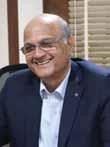
We are living through trying times. As the world comes to grips with having to confront the Covid-19 outbreak, I am reminded of Thomas Paine’s famous words “ These are times that try men’s souls. What we obtain too cheap, we esteem too lightly: it is dearness only that gives everything its value”.
Today, more than ever before, as quarantine and isolation become grim realities, we swear by sanitation and hygiene and the need for public awareness. WHO had of course flagged the need to focus on providing safe drinking water and promoting sanitation and hygiene in the century gone by. In 2017, WHO estimated that at least 2.3 billion of the world’s population was still without sanitation facilities and 884 million still lacked access to safe and clean drinking water.
The Rotary Foundation, through its WASH initiative, has been in the forefront of addressing this challenge. Since 2013, TRF has invested in many WASH stations in over 100 countries. It has also instituted a pilot programme to motivate Rotary clubs to develop a sustainable Water, Sanitation, Hygiene and Education Challenge for Schools. Five countries have been chosen for this pilot –Kenya (Africa), Guatemala, Honduras and Belize (Central America) and India. This was in recognition of their strong, committed involvement in school sanitation efforts.
This is also part of TRF’s Areas of Focus : Water, Sanitation and Hygiene; and Basic Education and Literacy.
Mark Antony, in Shakespeare’s Julius Caesar, says “the evil that men do, lives on after them; the good is oft interred with their bones”. However, this is not necessarily true. Sophocles, one of ancient Greek’s greatest writers of tragedies said: “To be doing good deeds is man’s most glorious task.” That’s what TRF does – doing good in the world. And given the hyper connectivity in today’s world, this is abundantly acknowledged as Rotary connects the world.
Friends, stay safe and stay well.

Gary C K Huang Foundation Trustee Chair
Gulam A Vahanvaty Trustee, The Rotary Foundation
Among the `20-crore worth projects planned by the Rotary Club of Calcutta, RID 3291, during this landmark year, the focus is clearly on health, hygiene and literacy. Immunisation and access to healthcare for slum children through St Thomas Home and Howrah South Point will cover 100,000 by the end of this year; over 700,000 have been already covered. Prevention of childhood blindness by timely screening of 10,000 children with special focus on retinal disorders and operating 1,000 children is yet another project.
Other centennial projects, Club
President Purnendu Roy Chowdhury says, are heart surgeries in partnership with the Rabindranath Tagore International Institute of Cardiac Sciences. Over 700 children and adults have been operated and by the end of year “we hope to achieve our target of 1,000.” Also, equipment worth $271,000 is being acquired through a global grant for Mercy Hospital.
Two other ambitious projects are a school hostel for 200 Adivasi children and building 1,000 toilets and 300 borewells.
Another projects, he adds is “the Howrah South Point bridge school for street children mentored by a French priest who was the inspiration behind Dominique Lapierre’s book City of Joy
Most senior Rotary leaders in India, while congratulating the Rotary Club of Calcutta for its centennial, have mentioned the burden and heritage of 100 years resting on the young shoulders of its president Chowdhury.
RI Director Bharat Pandya put it very eloquently when he said at the
Rasheeda Bhagat
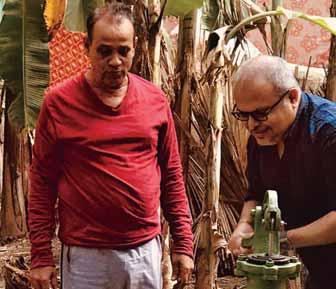
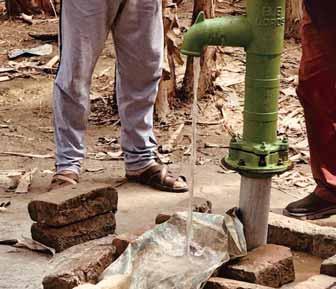


Charter Day of the club in Kolkata: “Undoubtedly, the club’s past has been splendid; we take pride in the past but it is time to move into the future. The torch of leadership is in the hands of your young president Chowdhury. I urge you to hold that torch a little higher, make it burn a little brighter and pass it on to future generations.”
Chowdhury is trying to do just that, and first among his many priorities this year it to “make a connect within the members, make the club stronger and also make connections outside.”
Towards that goal the club’s Centennial Committee headed by past president Saumen Ray is trying to connect with all the vintage clubs in Asia that are 100 years old or turning 100 soon. “We are planning an Asian Tigers meet; Shanghai, Manila, Calcutta and Tokyo, which turns 100 next year. We’re forming a consortium of these clubs and the first meet was held at the Centennial Summit,” says Chowdhury.
But what is heartening is that the cooperation on the ground has already begun. The Shanghai club has identified a Nigerian baby girl who needs a heart surgery, which will be done in Kolkata, says Ray.
The club also has huge plans on building schools. “After polio, we see literacy as the next big thing. So we
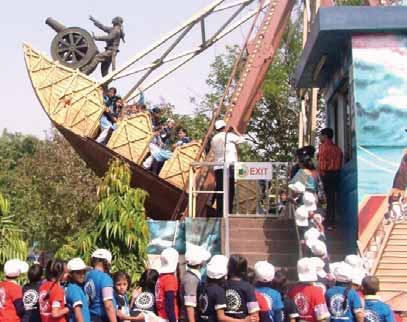
want to build bridge schools. Two of them are on course and the third one is being planned in Purulia.”
The first one is being built in Howrah, in partnership with a German club (RC KaufburenOstallgau) through a global grant, and the second in Darjeeling.
Does he feel burdened with a 100-year-legacy? “Not at all, because the members are sharing the work; the history book is being given finishing touches by Ritwik Gupta, and the project is led by PDG Rohatgi, a Rotarian of 61 years, and he doesn’t even look 61,” says Chowdhury, pointing to his senior’s yet-to-become-grey hair!

Do you dye your hair, I ask Rohatgi. As he smiles and shakes his head, wife Sashi says: “Never, it’s in their family. His mother never had a single grey hair.”
“Well, I already have grey hair and I am 50,” sighs Chowdhury.
“Finish your year, and you’ll be lucky to have any hair left,” quips the senior.
Jokes apart, Chowdhury adds, “nearly 40 club members, led by Saumen Ray, are sharing my burden!”
He adds that for many years the club members having been working on a school at the Bishnupur RCC near Kolkata “and recently we formed the Sri Aurobindo Siksha Kendra Rotary Primary School. Now our plan is to make Bishnupur a model RCC,” says Saumen Ray.
The icing on the cake is of course the club’s most beloved project — Children’s Treat — which has been going strong for 95 years, and perhaps gives more joy to the Rotarians, their Anns and the Rotaractors involved than the 1,500odd children who get a special treat every Christmas.
Addressing a meeting of past governors, Rotaractors and Interactors and other Rotary leaders from RID 3220 in Colombo, RI President Mark Maloney said that one of the great things about being an RI President was “that Gay and I have had the opportunity to travel the world to see the great work Rotarians are doing around the world, and to experience their fellowship and commitment.”
Earlier that morning, he said, he had visited two great projects — the Ayathi facility for disabled children, which was a GG project done by RC Colombo West and the Human Heart Valve Bank at the Lady Ridgeway Hospital, another global grant project done by RC Colombo Fort.
“It is amazing to see the work Rotarians are doing in Sri Lanka and rest of the world. In my district, one of the largest clubs is RC Birmingham
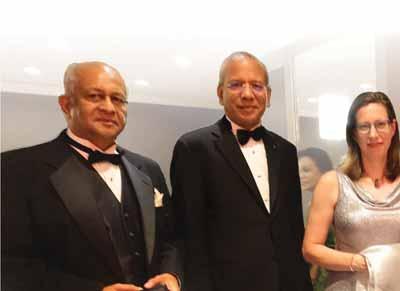
with 640 members, and (PRIP K R) Ravindran is an honorary member of that Rotary club. For the last several years both RCs Birmingham and Colombo have partnered on several projects, including, to me, the most significant project to eradicate cervical cancer from Sri Lanka. I am so impressed with this project that I had asked Ravindran and Dr Ed Partridge, former President of the US Cancer Society, and a member of
From L: Rtn Kumar Nadesan, TRF Trustee Chair Elect K R Ravindran, US Ambassador to Sri Lanka Alaina Teplitz, RI President Mark Maloney and Gay.
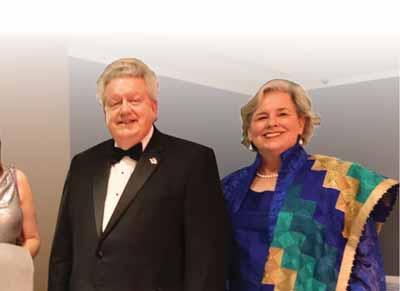
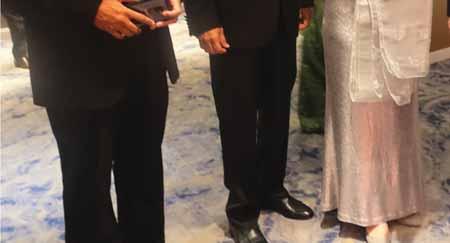
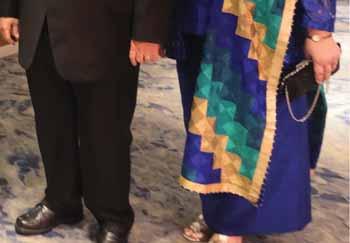
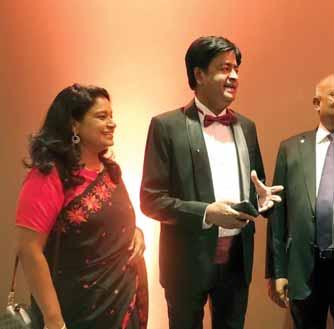
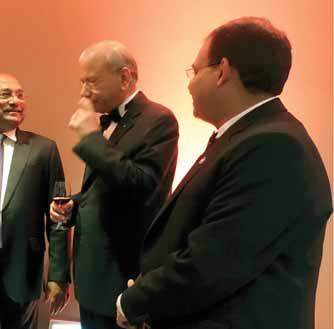
From L: Vinita, RIDN A S Venkatesh, PRID C Basker, TRF Trustee Chair Elect K R Ravindran and RID 3070 DG Sunil Nagpal.
RC Birmingham, to highlight this project for all the incoming governors at IA 2020.”
Reiterating how “personal connections are important too”, Maloney said that way back in 1994 when Ravindran, a PDG, was invited to be the training leader at the International Assembly for the second successive year, at the same IA, “there was another past governor from Alabama who received the invitation for the first time to be a training leader. And that young PDG was me, and Ravi, my senior, gave me a hard time then and still gives me a hard time now! But we look forward to his leadership as Trustee Chair from July. The Foundation couldn’t have been in better hands than his in the upcoming RY 2020–21.”
Maloney said Ravindran had already given a lot of thought to the management of TRF. “He realises how critical polio eradication is to us at this point. Recently he and Pres-
ident Elect Holger Knaack were in Pakistan interacting with its Prime Minister and Army Chief to make sure that we bring polio eradication to a conclusion in that troubled area of the world.”
Also the RI President added Ravindran “will bring his business savvy skills to TRF and make sure that we have a very tight ship.”
Hailing the district’s partnership with Toastmasters International in
For a tiny country like Sri Lanka to have two leaders of international organisations representing 1.6 million people is a great accomplishment!
Mark Maloney RI President
the training of Rotarians and Rotaractors in leadership skills, Maloney referred to the presence in the room of Toastmasters International past president Balraj Arunasalan, and quipped: “You have in this room past presidents from both Toastmasters International and Rotary International who are both from Sri Lanka. I kind of think you are punching above your weight! RI presidents in the US are dime a dozen. But for a tiny country like Sri Lanka to have two leaders of international organisations representing 1.6 million people is a great accomplishment!”
He added: “We’ve got to a point where we can’t be insular any more, we have to forge partnerships. Just as in polio we partnered with the Gates Foundation, WHO, UNICEF etc, this wonderful partnership is the way to grow Rotary and increase our impact by building a synergy between our two organisations.”
Pictures by Rasheeda Bhagat
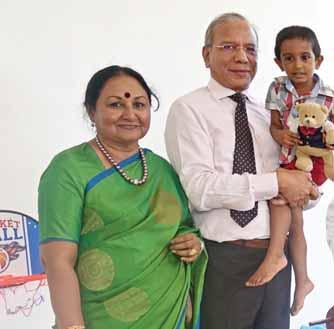
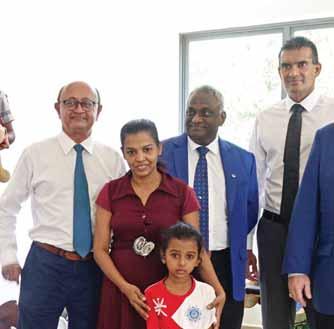

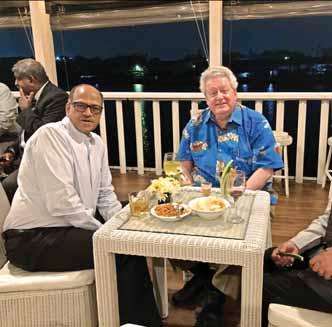


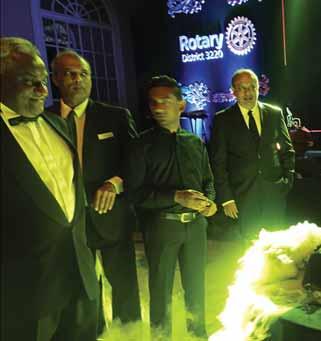

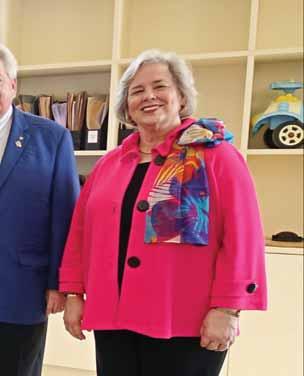



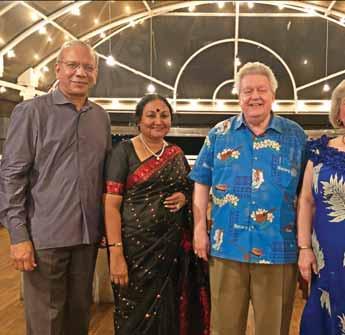

Left: RI President Mark Maloney and Gay with Vanathy, TRF Trustee Chair Elect K R Ravindran, RC Colombo West member Ajay Amalean, DG Sebastian Karunakaran and RC Colombo West President Pravir Samarasinghe at the Ayathi Trust.
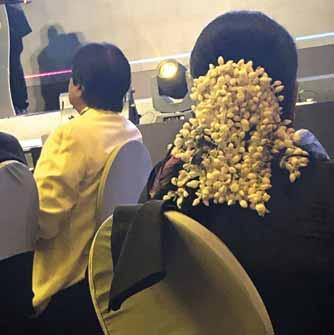
At a Rotary banquet... not in Chennai but Colombo.

Rasheeda Bhagat
It is the same old story everywhere… of special children being shunned by the general community that has little or no knowledge or understanding of disabilities. Sri Lanka is no exception; and a few years ago, Rotarians in Sri Lanka decided to partner
with the Sri Lankan government, its Army, medical and educational institutions and large corporates to support a unique project for special children.
This mega partnership has resulted in a colourful, vibrant, efficient, wellmanned and sprawling
facility for children with both mental and physical disabilities, aptly named Ayathi (Sanskrit for ‘hope’). A charitable trust established through joint collaboration between the University of Colombo, Hemas Holdings, MAS Holdings (both blue chip business conglomerates
in Sri Lanka) and Rotary Sri Lanka, this hi-tech spanking new facility is gearing up to provide a wide range of diagnostic, intervention and treatment facilities for special children.
During his recent visit to Colombo, RI President Mark Maloney

inaugurated the wellequipped acoustics centre at the Ayathi complex funded by a TRF global grant done by RC Colombo West.
Giving details of the entire project, incoming Trustee Chair K R Ravindran explained that this $3 million centre “spread across a twoacre land area and with a 42,000sqft built up space will provide services free of charge and is expected to be one of the finest such centres in South Asia.”
The University of Colombo made available
the land. The Sri Lanka Army built the premises in 13 months with two major cash infusions of $600,000 each from Hemas and MAS Holdings. “Both these companies have members of Rotary on their main board. Rotary Colombo West made available equipment with TRF global grants valued at about $400,000 with DDF support from districts in India and the US,” he said.
The Faculty of Medicine, of the University, would absorb all the operational and maintenance costs. It will provide trained professionals in the field
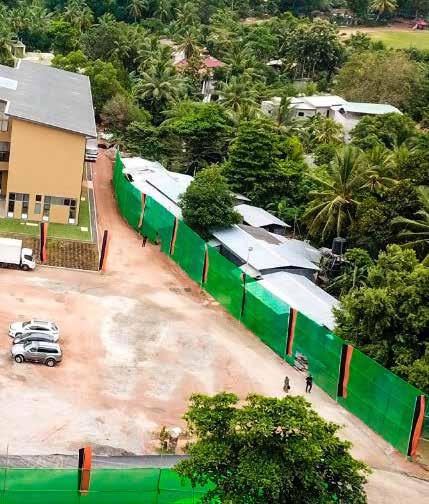
Togive the audience an idea of the level of stigma attached to disability, Shiromi Masakorala, executive director of the Ayathi Trust, who is a child psychologist as well, relates a few heartbreaking stories. In preparation for setting up this facility, she did an awareness “programme deep down in South Sri Lanka, and while delivering the vote of thanks, one mother said: ‘Every mother wants her child to live for 400 years but I want my child to die one hour before I die.’”
Her company, Hemas Holdings, a major donor to Ayathi, runs playschools for children and one of the mothers told them: “I carry my son 3 km to bring him to your centre. Still the bus doesn’t stop because my son looks ‘evil’… it is a bad omen for everyone to see him in the morning. But for me he is the most treasured gem…”
Another mother told her, looking at her disabled little daughter: “I had so many dreams when I conceived you my little girl… that was only a dream and you have come to this world to pay for your sins. But whatever you may be, I will love you and care for you; unfortunately your father and his family left us to fend for ourselves. But I will be with you till death parts us.”
On one occasion, Shiromi added, she found a child tied to a tree with a chain near a river, while the mother worked close by. “So I asked the mother and she said my family has left us because my child has a mental illness, so I have to work to support both of us. But I can’t leave him free, because there is nobody to watch him and he might jump into the river, so I have no other option but to tie him to the tree. Can you imagine this?”
Also, at their playschools, they find often that if a disabled child is admitted, other parents take away their children. This is the level of stigma attached to disability.
So apart from giving money to Ayathi, how can Rotarians help, I ask her. “Oh, they can help in a big way in running social campaigns to eradicate the stigma associated with disability. After all, they eradicated polio from Sri Lanka, and can surely help this cause in a big way,” she responds.

of disability studies. The areas covered extend to all disabilities (physical and mental) with initial screening and intervention that will include Speech and Language Therapy, Audiology, Physiotherapy, Family Therapy, Occupational Therapy etc. It will also provide the support and guidance for parents and caregivers. The centre already has registered outdoor patients (children) nationwide numbering over 5,000, added Ravindran.
Shiromi Masakorala, executive director of the Ayathi Trust, said that there is a huge need in the country for treating “children with disabilities, training them and giving them vocational skills in
order to make them useful and productive members of society.”
Reeling off statistics, she said that when the whole idea of setting up such a facility came up in 2016, “we did a
comprehensive survey and found that about 20 per cent of children in Sri Lanka — that is one child in every five — have some form of disability or another. Globally 2 to 5 per cent of children have
cerebral palsy; and 18 per cent have dyslexia. In Sri Lanka, most often they don’t know what dyslexia is, and the child would be either isolated or branded as not-so-brainy, or a slow learner and sidelined.”

From L: President Maloney, Gay, Pravir Samarasinghe, President, RC Colombo West, DG Sebastian Karunakaran, RID 3070 DG Sunil Nagpal, Shiromi Masakorala, Executive Director of the Ayathi Trust, Rtn Ajay Amalean of RC Colombo West, TRF Trustee Chair Elect K R Ravindran, Vanathy, Rtn Abbas Esufally of RC Colombo and RIDN A S Venkatesh.
Trustee Chair Elect K R Ravindran watches a child play on a trampoline. President Maloney is also seen in the picture.
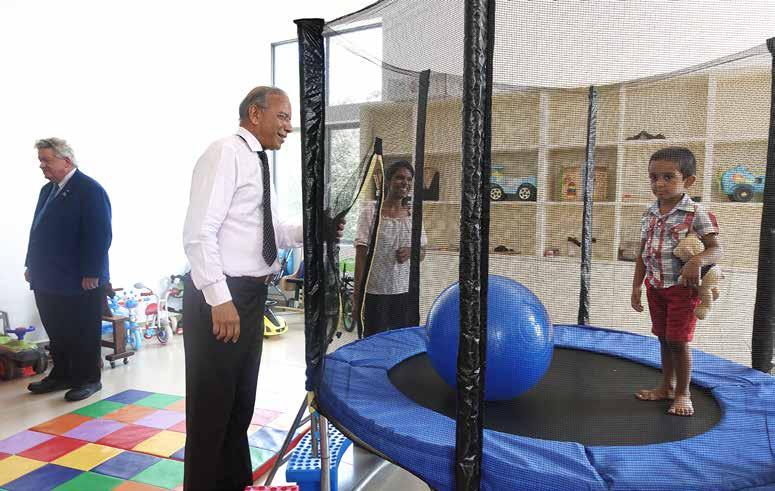
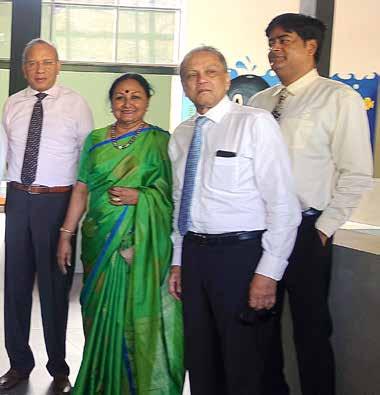
If such children can be identified at an early age and the right intervention and training given to them, they can be integrated into mainstream society and even regular schools. “Our aim is to do such integration; at this centre, kids will be referred from various places in the country, evaluated by a multi-disciplinary team of experts at day clinics, given appropriate intervention and vocational training specially designed for children with disabilities. The assessment will be done by specialist paediatricians
and the intervention required will be given.”
The best part about this modern, state-of-the-art facility filled with fun play material for children is that even though it comes under the umbrella of the faculty of medicine, “it is not within a hospital, but a community setting, so the children don’t feel like they are sick or are patients. And here we can deal with a multitude of disabilities to make the children functionally optimal,” she added.
As the team of senior RI leaders went around the facility, with the experts
explaining the various technical details of the different training functions available, Gay Maloney could be seen reaching out to the children, chatting and playing with them.
Shiromi added that the biggest challenge in integrating these children into mainstream society is the huge stigma attached to disability, “not only in Sri Lanka or Asia but even the most developed countries in the world.” On the one hand, while there is a shortage of trained professionals to deal adequately with special children, on the other hand “there is a lack of support system for the caregivers, parents and teachers. And then there is the negativity; when a child is born with a disability, the parents and the entire family become hopeless, helpless, start spending money on all kinds of things. To give hope to such parents/caregivers we have named our trust Ayathi.”
Going forward, the Ayathi Board wants to ensure that this facility not only becomes a world class centre of excellence but is also sustainable in the long term, and hence the importance of public and private partnerships. Also, the Ministry of Health is planning to take this concept to other
teaching hospitals. A residential centre is also being planned as this centre gets referrals from all over Sri Lanka.
Inaugurating the well-equipped Audiology Centre donated by Rotary, RI President Maloney said, “Here is a great example of Rotary connecting different organisations with Rotarians of the world to come up with an outstanding world class centre for children with disabilities. What a proud day for Rotary.”
PRIP Ravindran added that this was the type of projects that “the new projects of scale to be launched by TRF next year will try to emulate. This programme will challenge Rotary clubs to think big and approach co-partners and sponsors to join them in a comprehensive solution to major issues, the benefits of which will reach a large section of population. In this case the whole country will be served.”
Later, President Maloney also visited a Human Heart Valve and Tissue Bank, set up by RC Colombo Fort through a global grant, at the Lady Ridgeway Hospital in Colombo. Here human heart valves are harvested and stored and used for operating on children with

Gay reaching out to a special child at the Ayathi complex.
defective heart valves. Here the cardiologists explained to the visitors that while artificial heart valves or those taken from animals can also be used, “these valves can get calcified fast, whereas those taken from humans last longer, and where available, these are the first preference anywhere in the world.”
Such valves have to be harvested from cadavers within 24 hours of death and even adult valves can be used in children. “These can be stored at this bank for a year at a very cold temperature;
at present we have four usable heart valves. Not all harvested valves can be used; we have to do a culture to make sure there are no organisms in the valve. At the slightest suspicion we reject the valve,” explained a doctor.
But the good thing about Sri Lanka is “Sri Lankans donate their organs without hesitation; we haven’t had a single issue of people refusing to donate.”
Pictures by Rasheeda Bhagat Designed by Krishnapratheesh S

PRID Manoj Desai is appointed by RI as one of the six members of the Operations Review Committee which is chaired by PRID Karen Wentz. The assignment is for a six year term and involves reviewing the effectiveness and efficiency of operations, administrative procedures, standards of conduct and other operational functions as assigned by the Board. This committee also serves as the advisory compensation committee to the Executive Committee.
You can pay the Rotary News / Rotary Samachar subscription online
Our Bank details: Bank : HDFC Bank SB Account Branch : Montieth Road Egmore, Chennai
A/c Name : Rotary News Trust
A/c No. : 50100213133460
IFSC Code : HDFC0003820
E mail us following details:
Name of Club
President/Secretary’s name
Amount/Date of transfer/UTR Number
For physical payment by cheque or cash in bank, write Club Name only without prefixing “Rotary club of”. Eg. Rotary Club of Delhi Central should be written: Delhi Central.
V Muthukumaran
Long after the dust settled down with the speakers, sessions and late-night partying fading into distant memory, one showpiece continues to shine in our hearts. Yes, the House of Friendship, nicknamed the Kolkata’s adda zone, was the prima donna of Rotary India Centennial Celebrations in Kolkata.
The three-day camaraderie and fellowship witnessed at the HoF kept the delegates on their toes, excited to strike new friendships, share notes on best practices, tuck in the delicious Kolkata and traditional Indian food, shopping at various stalls, and above all,



enjoying the music and dance as they unwinded at the end of the day. “We wanted to give once-ina-lifetime experience to our delegates and the HOF was designed to create an ambience to attract increased footfalls on all three days,” said PDG V Raja Seenivasan, Chairman of the HoF Committee.
Broadly, the indoor space was divided into four segments — food court; podium with seating arrangement; HoF stalls; and a highdécor lounge — that were buzzing with excitement and chatter all through the day. Rotary projects (77 stalls), commercial booths (14) and Kolkata Bazaar (14 exhibits) made up a

Dancers welcome RI President Mark Maloney and Gay into the HoF. RID Kamal Sanghvi, Sonal and RIPN Shekhar Mehta are also seen.

From L: Centennial Summit
Secretary Kishore Kumar Ch, PDG Tikku, Shobha Kishore, and DG M Veerabhadra Reddy enjoying the food at the HoF food court.
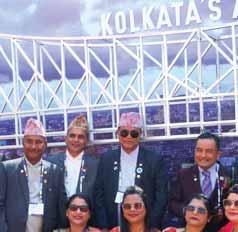
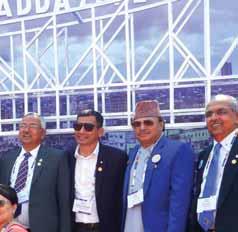






total of 105 stalls at the adda zone.
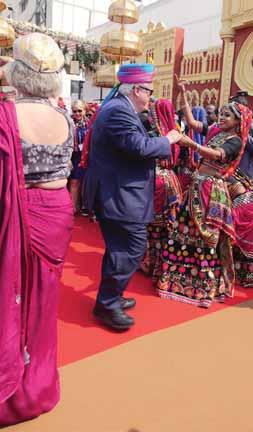
Some of the flagship and renowned projects of Rotary India including TEACH, PolioPlus, LN-4 and Jaipur limbs, heart surgeries, WASH programmes, and Happy Schools besides booths from RIDs 3291, 3030, 3170, 3201 and 3012 were showcased in one half of the indoor arena. “The Kolkata Bazaar was designed to give a shopping feel, of the streets and bylanes of the city of joy. A centennial lounge helped delegates to unwind, relax and engage in casual talk, while seated on cushioned upholstery,” said Seenivasan. On another platform, a medley of Bollywood musicals and group dance on the stage regaled the audience.
At the food court, a variety of Indian cuisines, Italian, Chinese and Continental menus across the 20 food stalls
A hub of Rotary spirit and bonhomie, the HoF attracted 4,000 footfalls a day, with many delegates visiting it many times to get a flavour of this unique fellowship.
titillated the taste buds of Rotarians.
City landmarks
In fact, a mini Kolkata with models of an age-old tram and a hand-pulled rickshaw turned out to be a big hit among the delegates. Overawed by the colourful sights and the ambience, RIDE Valerie K Wafer from Canada, RID 7010, said, “The HOF inauguration by President Mark Maloney and Gay was such fun and beyond spectacular. This expo with stage programmes is similar to the ones we have in Canada, but the diversity here is just amazing. We loved the food and got an opportunity to collaborate with your projects on display.”
A traditional group dance welcomes RI President Maloney and Gay at the inaugural.
PDG Aniruddha Roy Chowdhury with spouse Shipra and a delegate.
Women delegates in front of Kolkata’s colonial houses reminiscent of the British-era.
DG Madhav Chandran, RID 3201, with spouse Sujatha and PDG Sanjay Khemka.
Calcutta’s yellow cab, one of the hot selfie spots at the HOF.

For many delegates, the HoF gave a platform to interact with Rotary leaders, network and create new friendships. “We rediscovered old friendships, struck new ones and bonded over
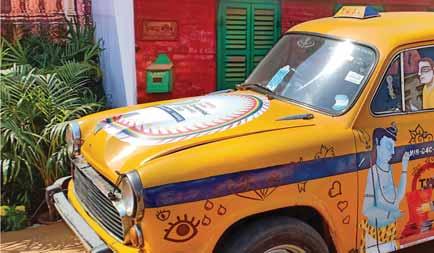



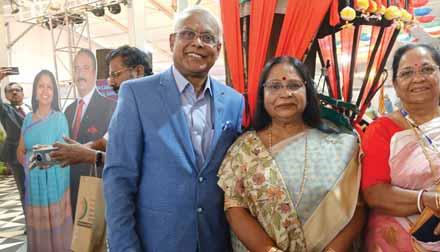


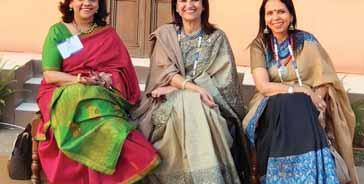



fellowship,” said Abhishek Sonthalia, President-elect, RC Jaipur Round Town, RID 3054.
An impressive show Going around the stalls, landmark models and tableaus, RIDE Peter Kyle from Washington DC, RID 7620, said the HoF was user-friendly, well-designed and a great pleasure to visit.
Vinod Saraogi from RC Madras Central and his wife Usha, Chairmanelect, Inner Wheel 323, said they got a feel of vintage Calcutta with the nicely done interiors and outdoor structures. If the food court and stalls won a lot of praise from delegates, then the credit must go to PDGs Sanjay Khemka and Sandeep Narang who had conceptualised and designed the entire adda zone to reflect the Centennial spirit.


The process of ‘joyful learning’ was spontaneous at the HoF for Gaurav Agarwal Jain from RC Kanpur, RID 3110, and DRR Alok Pandey. “It was really pleasant to be at the venue as we exchanged ideas with delegates from around the world. And in the context of #Elevate Rotaract, the youth will get an idea of how good an international conclave can be in terms of knowledge sharing,” said Pandey.
At the entrance to the adda zone, facades of heritage buildings such as the Victoria Memorial, Howrah bridge, Dakshineswar Kali temple, Calcutta High Court, Kolkata Metro, the yellow Calcutta cab, the Shaheed Minar, and a series of vintage Calcutta houses were hubs for taking selfies, and capturing some romantic moments for Rotarian couples.
DGE S Muthupalaniappan, RID 3232, said that the HoF was unique and offered a nice platform for networking among global delegates. “The venue was spacious, aesthetically designed and helped Rotarians to intermingle and strike lasting friendships,” he said. A hub of Rotary spirit and bonhomie, the HoF at the Centennial Summit attracted not less than 4,000 footfalls a day, with many delegates visiting it many times a day to get a flavour of this unique fellowship.
Pictures by V Muthukumaran and Rasheeda Bhagat
Designed by Krishnapratheesh
Global Grants in India — A conversation with incoming TRF Trustee Chair
K R Ravindran and Trustee Gulam Vahanvaty
At the Indore Zone Institute, a session that generated lot of interest and debate, pertained to global grants (GGs). Many expressed unhappiness over the rejection of their grant applications. The general feeling was that they weren’t given any reasons or explanation on why their grant applications were being rejected.
Incoming Trustee Chair K R Ravindran and General Secretary John Hewko, who were on the panel,
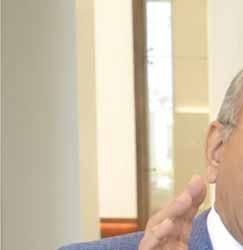

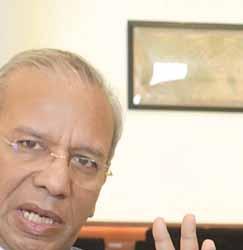


addressed some of the concerns on the spot, and Ravindran promised to revert with answers to the questions raised within three months, with facts and figures pertaining to GGs.
Rotary News caught up with Ravindran, TRF Trustee Gulam Vahanvaty, and RI staff dealing with GGs Abby McNear and Meredith Burlew to find out why some GG applications work, while others don’t. Most important, what norms a club should follow to plan and execute an effective and successful project

with the help of a GG that is speedily processed and approved.
The buzz in India these days is that Rotary India is the Kohinoor in the crown of RI, a sentiment first articulated by RI President Nominee Shekhar Mehta. He had said this in an interview to Rotary News in the context of Rotary in India topping the charts on membership, emerging second in TRF giving and doing great community service projects.
Asked to respond to the Kohinoor title and the service projects Indian
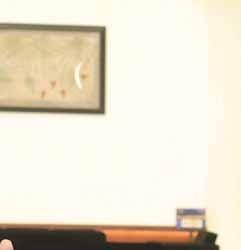

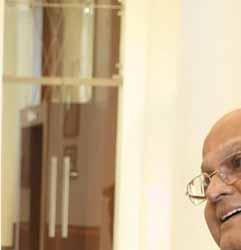
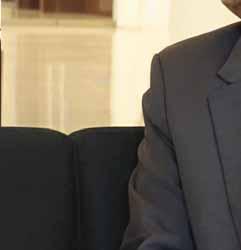

Rotarians do, Ravindran says: “If we were to judge by the enthusiasm and results demonstrated through TRF activities of Indian clubs and districts, we would agree with him, without, of course, taking away any credit from the other big users of TRF.”
He says an analysis of “the big users of our GGs shows that India unequivocally leads the pack and in doing so, it more than contributes its mite to making this country a better place to live in. We can be proud of that.”
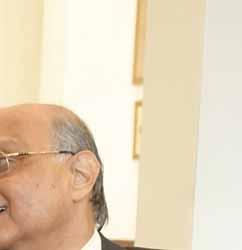
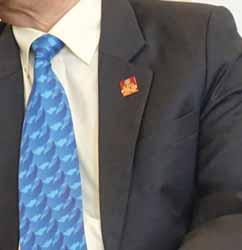
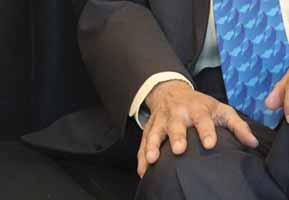



Our business is life itself — and to so many of those we help, our business is the business of miracles.
K R Ravindran Trustee Chair-elect
The Rotary Foundation
Here are the statistics the incoming Trustee Chair gives: In RY2019 (all years mentioned are Rotary years: July-June), India hosted 269 global grants worth $21,516,796 or (about `151 crore) in combined funding. England which hosted 101 global grants was a distant second.
“In analysing the nature of the grants, it is clear that a lot of funding goes to supply medical equipment (particularly for dialysis), toilets and equipment in schools. Last year, 44
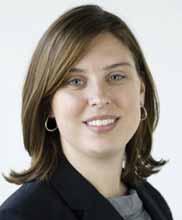
Meredith Burlew, Stewardship Manager, Rotary International
projects were on basic education and literacy (BEL). But we must also note that of the 53 BEL projects TRF declined worldwide in 2019, 33 were sponsored by India.”
In 2018, the Foundation approved 95 per cent of GG applications; in 2019, after the Foundation asked that applicants to share the results of their community assessments, that number dropped to 89 per cent and this year it stands at 85 per cent. While an 85 per cent approval rate is incredibly high for any foundation, it is down from the previous high of 95 per cent, he adds.
So how and why did that happen, I ask Ravindran. “Our study of projects which were rejected had a common thread. Instead of community assessment guiding the design of their project, our Rotarians frequently look to reach the greatest number of beneficiaries possible. While understandable, this practice can lead to implementation issues stemming from a lack of project planning and oversight.”
Trustee Vahanvaty adds that the strongest projects were those that had “robust community assessments and strong
Being able to say ‘we gave some equipment to 100 schools’ is not the same as saying, ‘Thanks to Rotary, the children’s reading comprehension has risen 10 per cent and attendance is at an all-time high.
Abby McNear Director of Grants, TRF
Rotarian participation, including the active involvement of club or district members beyond the primary contact.”
Ravindran likes to refer to Rotary as a business and as RI President he had focused a lot of his time and energy on reducing operational costs and had succeeded substantially. Asked to explain why he equates Rotary’s work akin to running a business, he says, “Yes, it is indeed a business, but like no other. Our business is literacy and health. Our business is livelihood and hope. Our business is life itself — and to so many of those we help, our business is the business of miracles.
“Let’s say we are building a petrol pump on a highway location. We will first assess the quantum of traffic on that highway.” The questions that need asking are: Where is the closest petrol bunk? Is diesel or petrol more popular and accordingly how many pumps are required? What about storage of fuel? The pump attendants need to be trained and the office manager taught about reordering levels, cash collections, etc.
“But we would not simply build a petrol pump because it looked good and might serve someone who requires petrol or diesel one day, and hope that it works!
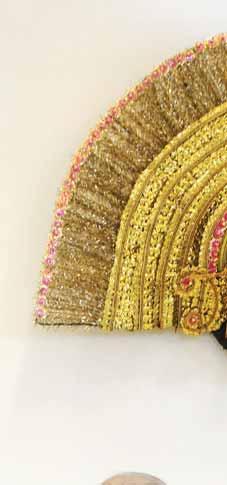
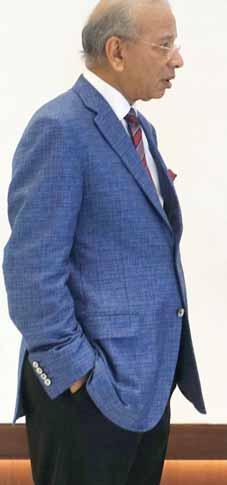

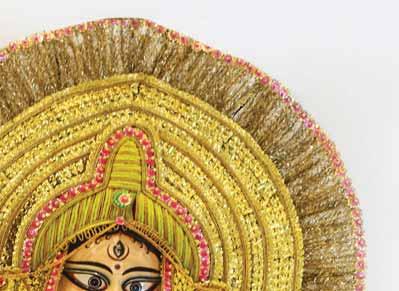
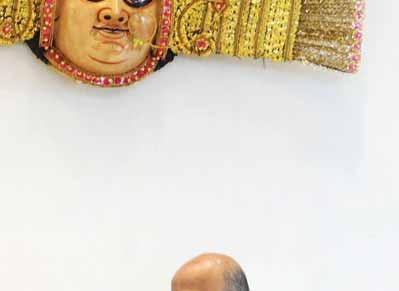
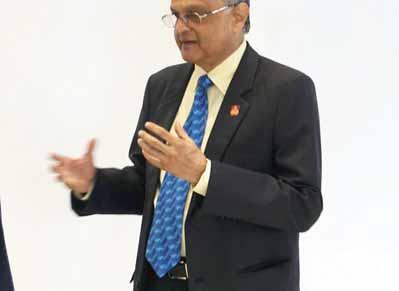

Rotarians have often told us that in a country like India, one toilet in a school is better than no toilet; The Trustees deem that if a school needs seven toilets then building one will not suffice.
Gulam Vahanvaty TRF Trustee
Why should it be any different in a Rotary project?
“Our study showed that grant management issues were most common when Rotarians did not conduct a community assessment to determine the beneficiaries’ priority needs, or did not involve the beneficiary community in project planning. We looked for a real example as to what happens when Rotarians do not conduct a proper community assessment.”
Asked what this study found, Trustee Vahanvaty says, “We discussed with Meredith Burlew, who heads TRF’s Stewardship Department. Meredith works closely with our cadre members and has been with TRF for over 13 years, has been Rotary’s stewardship manager since 2012, and has reviewed over 300 audits of Rotary grants. She was present in Kolkata earlier this year at the DISHA programme where she shared some examples collected from over 40 audits that were completed within the year,
most of which were well executed.”
One project she did mention was approved to provide clean water to schools. She pointed out that it was primarily vendor-driven; Rotarians distributed filters designed for home use to schools that in some cases had over 800 children. The filters were the same at every school, regardless of school size or input water quality. “Many of these systems failed, and precious Foundation funds were wasted and Rotary’s name was sullied due to the poor project quality.”
In another project, a district secured a grant for its clubs to provide a large number of metal school benches to numerous schools. In some cases, the benches were far too large for the small children they were intended to benefit. “They became rusty and their sharp edges proved a hazard. Ultimately, the teachers removed them from the classrooms. Once again, precious Foundation resources were wasted and Rotary’s reputation suffered, all for the lack of
Against every negative or a GG going wrong, there are several that are planned and executed well. As Trustee Vahanvaty adds, “The ‘bad’ examples are being shared here so that we may learn from them. The ‘good’ projects far outnumber the bad. To quote these good examples, Rotary News caught up with Abby McNear, Director of Grants in Evanston, to get an insight on what really works in global grants.
Abby said that a lot of problems stem from “how we approach projects in schools. Over and over, the Foundation sees projects where the primary goal is to supply equipment to the largest number of schools possible. Nowhere in the Trustees’ BEL policy statement or WASH policy statement, will you see a goal focused exclusively on providing equipment.”
This approach to designing projects works in a district grant context, but is absolutely at odds with the eligibility criteria for GGs, “which are the
Foundation’s showcase projects. They are meant to be transformative with measurable improvements for the beneficiaries. Being able to say ‘we gave some equipment to 100 schools’ is not the same as saying, ‘Thanks to Rotary, the children’s reading comprehension has risen 10 per cent and attendance is at an all-time high.’ You can do the former project without a community assessment. The latter will never happen unless one is done.”
Asked to give examples of a good GG project, she said, “The Rotary Clubs of Bombay (RID 3141), RC Thane Hills (RID 3142) and Colombo (RID 3220) partnered together on a GG to provide professional development to the principals, education officers and teachers at 100 schools in Thane. By focusing on these professionals, the clubs knew that the 24,000 children who attend school in Thane would ultimately benefit.”
She gave two other examples of GGs that went smoothly as they

satisfied all criteria laid down by the Trustees.
One was sponsored by RC Madras South (RID 3232) and RC Pasadena (RID 5300). Its objective was to do about 230 corrective heart surgeries and follow up care for beneficiaries at the Sooriya Hospital in Chennai. It aimed to address the paediatric cardio surgery needs of poor children and help them lead a healthy life.
The project assured an end-to-end solution for parents whose children had been diagnosed with congenital heart disease. The surgeries performed at Sooriya Hospital and supported by the two Rotary clubs were not just more affordable and accessible than many others in the market, but also ended up being free of cost to the family.
The project aimed, and turned out to be, “a breath of fresh air and a reassuring safety blanket to families in need of support to help save their children.”
Another global grant that satisfied all TRF criteria and worked was for a

WASH in Schools project to provide hygiene education training to students and teachers and build toilet blocks in eight schools in Jodhpur. Sponsored by RC Jodhpur Padmini (RID 3053) and RC Bentonville (RID 6110), US, the objective of this project was to make sustainable improvements in the sanitation and hygiene of eight schools in this Rajasthan city, benefitting nearly 2,000 students. It aimed to build new handwash stations, utensil wash stations, drinking water stations and upgrade toilet blocks for boys and girls. The project also provided sanitary napkins and training on menstruation to about 630 girls from Class 6 onwards, established a maintenance system for the facilities, conducted sanitation and hygiene training. It benefitted primary and secondary government-run schools attended by underprivileged students. The upgraded facilities provided a better educational and more sanitary environment, and the training set in behavioural changes by creating awareness in students and faculty, and contributed to the retention of students, especially girls.

Abby McNear Director of Grants, TRF
A year prior to the project, RC Jodhpur Padmini club members visited 30 government schools to survey the prevalent conditions. In addition, the club undertook numerous service projects, including hygiene training, in the government schools during the previous five years. Through these projects and the visits to these schools, the club identified the need for improved sanitation and hygiene education and infrastructure and zeroed in on the eight schools for this project.
The school staff and students shared their problems during club members’ visits to the schools. The schools were very receptive and enthusiastic about the contributions the club had already made during the past five years through various service projects and responded warmly to this opportunity to improve their sanitation and hygiene infrastructure and practices, said Abby.
So, successful global grant projects at a large number of schools can be done, but it means “thinking big in terms of the project’s goals and focusing on better educated children as opposed to simply providing equipment. It’s all about the project goals.”
So where do we go from here?
Abby responds: “Lots of help is available. Grants staff can pre-review your project ideas and offer advice. They can also connect you with a local cadre member for help. The Foundation has guidelines for GG projects in every area of focus, but the BEL guidelines for GG funding are the most helpful for school projects.”
the simplest community assessment,” says Vahanvaty.
In yet another example, a district secured a grant for its clubs to install incinerators for sanitary napkins. The clubs had no understanding of the project and the incinerators were either installed in a primary school where there was no need, or worse, placed adjacent to the toilets where children could be burned from the hot metal. The smoke from the burning plastic that spewed from these incinerators sullied the air.
“The Foundation should not be involved in projects like these. It wastes the limited funds donors have
given for global grants and does nothing for Rotary’s reputation. We can, and we must do better,” adds Vahanvaty.
There is also the philosophical difference between what the Trustees deem fit and some calls that are made by districts, says Ravindran. “Rotarians have often told us that in a country like India, one toilet in a school is better than no toilet; But in safeguarding funds collected from around the world for GGs, Trustees do not subscribe to that view. The Trustees deem that if a school needs seven toilets then building one will not suffice. They believe that
one toilet would probably become unusable in a few days and the users will simply return to their old habits. If a class needs 10 benches and bunks, two won’t do and so forth.”
However, he adds, if district grants are the finance source, then clearly TRF has no proprietary right over it and it becomes the district’s own decision.
Adds Vahanvaty, “It is our Centennial year. Let’s do what we must to have our GGs work and show Rotary at its best.”
Pictures by Rasheeda Bhagat Designed by Krishnapratheesh
Vice-President of India M Venkaiah Naidu urged delegates at the Centennial conference of Rotary India in Kolkata to ensure that the declining interest in youngsters to
take up agriculture as a profession was arrested. He suggested that Rotary should train and skill youngsters to become “agri-entrepreneurs”.
Recalling his visit to the 2014 Chennai Zone Institute where Rotary
signed an MoA to work with the Indian government for the Swachh Bharat campaign, he said, “I understand the importance of working together with you and learning from each other’s experiences,” and listed out Rotary’s
RID Kamal Sanghvi honours Vice-President of India M Venkaiah Naidu in the presence of West Bengal Governor Jagdeep Dhankhar, State Minister of Science and Technology Bratya Basu, RIPN Shekhar Mehta, Trustee Chair Gary Huang, RID Bharat Pandya and Summit Secretary Kishore Kumar Cherukumalli.


RIPN Shekhar Mehta explains a WinS Project to Vice-President Venkaiah Naidu, West Bengal Governor Jagdeep Dhankhar and State Minister for Science and Technology Bratya Basu at the HoF. Also seen are Centennial Summit Joint Chair Anirudha Roy Chowdhury, HoF Committee Chair V Raja Seenivasan and Centennial Summit Chair Vinod Bansal.
humanitarian activities in various fields across the country.
Earlier a delegation of senior Rotary leaders — RIPN Shekhar Mehta, Convenor of the summit and RID Kamal Sanghvi and RID Bharat Pandya, along with the Centennial Summit Chair Vinod Bansal, Joint Chair Anirudha Roy Chowdhury and Secretary Kishore Kumar, took the Vice-President around the HoF. He was particularly impressed with the stalls that showcased Rotary’s WinS and Literacy programmes and complimented Mehta for the series of
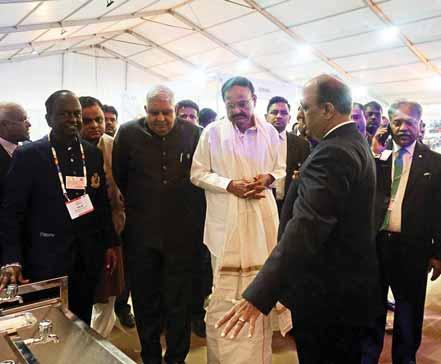
activities Rotary India has lined up during the centenary year.
Touching upon climate change and its impact on the world, he urged Rotarians to promote programmes to protect the environment. He stressed the importance of sanitation and clean water and expressed concern on the increase in non-communicable diseases. “Rotary must promote awareness, particularly among youngsters, about the harmful effects of a sedentary lifestyle and unhealthy food habits.”
work towards bridging this ruralurban divide,” he said and appealed to all countries to come together to address global challenges such as illiteracy, poverty, gender and social discrimination.
Rotary must promote awareness, particularly among youngsters, about the harmful
Underlining the importance of peace, Naidu said the involvement of local communities was essential to create a global consensus on platforms such as the UN for a strong policy framework against all forms of terrorism. “Peace is a prerequisite to development. Everyone should work to curb the menace of terrorism,” he said.
Highlighting that more than 60 per cent of Indians still live in villages, Naidu urged Rotary to focus on strengthening rural economy. “Lack of basic amenities and employment opportunities in rural areas is causing forced migration. We should seriously
He made special note of the generous contribution of Rajashree Birla, Chairperson of the Aditya Birla Foundation for Community Initiatives and Rural Development, and D Ravishankar, past president of RC Bangalore Orchards, to Rotary. There is no dearth for such kind-hearted people in India and it is up to us to identify and impress upon them to contribute for worthy causes, he said.
Acknowledging Rotary’s “phenomenal role” in polio eradication in India, Naidu said that this achievement was “a perfect example to show how the government and committed NGOs can forge effective and successful partnerships to work for common good.”
He was accompanied by West Bengal Governor Jagdeep Dhankar and Minister for Science and Technology Bratya Basu.
Pictures by Jaishree
Two social entrepreneurs did not pull their punches at the Centennial Summit in Kolkata on two issues — child hunger and lack of clothing. PRID C Basker chaired the session titled ‘Growing local economies’.
While Anshu Gupta’s Goonj, a Delhi-based NGO, works in recycling urban waste and garments to provide dignity to millions of poor families, Akshaya Patra’s Chief Marketing Officer Sundeep Talwar is keen to improve the enrolment ratio in government schools through the NGO’s Midday Meal programme.
More people die for want of proper clothing than due to natural calamities in India, but there is no dearth of resources to provide decent clothing for deprived people, said Anshu Gupta. He resigned from a high corporate post, and started Goonj in 1999 to work for the betterment of marginalised people by giving them decent clothes and educating them on adopting better hygiene and sanitation.
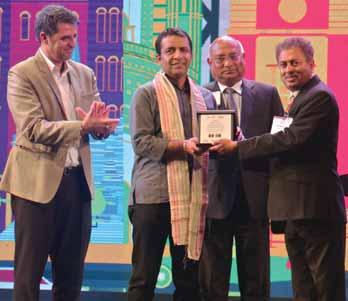

“A person is evaluated by what he or she wears; the reality is that while higher education is highly subsidised, we take exception to farm subsidy which helps farmers earn a decent income,” he explained. In a year, Goonj had recycled over 6,000 tonnes of urban material, discards and throwaways, by converting them into new clothing and sanitary pads. While urban poverty due to lack of clothing, shelter and food has to be tackled, in rural areas the mounting farmers’ suicides, despite the eligibility for minimum wages, only pointed to the skewed priorities of the government, he said.
If the impoverished migrants from villages have to transition from social discards to a charity must stop. It kills the self-worth of the
Charity must stop If the impoverished migrants from villages have to transition from social discards to those leading a dignified life, “sustained charity must stop at sometime as it kills the self-worth of the beneficiary.” Pride is always important to rural migrants who had once led a self-sustained life back home and now had to struggle to make both ends meet, he noted. “We have to make the poor the decision-makers by understanding their problems and open up opportunities for
them to access basic infrastructure and create a sense of ownership for them,” Gupta explained.
The perception and thought process on ‘unskilled workers’ and the rural workforce need to change, for, despite not having formal education, “they have built rural roads, created tank bunds and constructed schools with a sense of dignity and satisfaction, but without entitlement,” he added.
When he began work on menstrual hygiene in 2004-05, Gupta found it was a taboo subject and there was an extreme shortage of sanitary pads resulting in adolescent girls using dangerous
and unhealthy things like shacks, grass, grains, recycled clothes and dried leaves to manage their menstrual cycles.
Talwar reeled out startling statistics in his speech. “Nearly 15 per cent of our population is undernourished as 196 million people go hungry everyday in India with women forming 60 per cent of starving people; 21 per cent of children under five are underweight; with 1 in 4 being malnourished.”
Why kids drop out?
Some of the reasons for children dropping out of schools include the school being too far from home, the children having to
Rotary Club of Virudhunagar Elite, RID 3212, has facilitated safe drinking water for
15,000 schoolchildren by installing RO plants in 11 schools in Virudhunagar, a town near Madurai. The
The realities are striking in that while higher education is highly subsidised, we take exception to farm subsidy which helps farmers earn a decent income.
supplement the household income, education not considered a necessity or the need to attend domestic chores. “Akshaya Patra attracts children back to school through the Midday Meal programme covering 18 lakh children in 16,800 schools across 13 States with support from 52 kitchens. It is the key incentive
project costing $65,265 was implemented through a global grant with RC FMAM, RID 5580, USA, as international partner.
“We were able to get this grant through, thanks to the Term Gift of $50,000 given by DGE P N B Murugadoss to TRF in 2016 when his club, RC Rajapalayam, celebrated
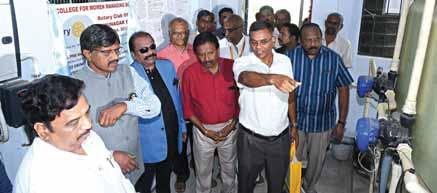
for bringing 9 out of 13 children to school regularly,” he said. The project now includes breakfast for children, besides lunch.”
Huge opportunities
Rotary clubs can join hands with the local chapters of Akshaya Patra for efficient supply of packed meals to schoolchildren in delivery trucks, Talwar said. Matching grants and crowdsourcing platforms can be explored for raising funds. “You can help us in setting up kitchens, train the staff and to rope in Rotaractors for the Midday Meal project,” he added.
Picture by V Muthukumaran
its golden jubilee,” said C Marimuthu, the project’s primary contact. Murugadoss had earmarked his contribution for water and sanitation, one of Rotary’s six areas of focus. The students were happy to have access to drinking water in their schools. “We used to carry two bottles of water from home and our parents forbade us from sharing water with others. Now we bring empty bottles, fill them with water and take them home,” said a student from a beneficiary school.
DGE P N B Murugadoss, DG Sheikh Saleem, PDG B Arumugapandian at one of the beneficiary schools.
With their black and yellow tees, 12 men marked their presence at the Centennial Summit in Kolkata this February. They were felicitated by RI President Mark Maloney in the presence of RIPN Shekhar Mehta and Convenor of the Summit and RID Kamal Sanghvi and RID Bharat Pandya. The team led by Sunil Telkar arrived at Kolkata completing a rally called the ‘Rotary Literacy Ride 2020’ starting from Kanyakumari, traveling 4,600 km through 16 cities and 14 Rotary districts in 19 days. The rally was to promote Rotary India Literacy Mission’s Asha Kiran project to put children back to the school.
“What started as a mere fun ride turned into a once-in-lifetime experience for all of us,” said Telkar, member of RC Bangalore Kalyan, RID 3190. The rallyists are Rotarians of RID 3190, and members of the International Fellowship of Motorcycling Rotarians. Telkar is a former president of this organisation. This is the longest ride for the team which has gone on frequent short trips.
The idea for the ride was conceptualised by D Ravishankar, past president of RC Bangalore Orchards, who also pitched in with a
Jaishree
contribution of `150,000 to meet the ride expenses.
“RIPN Shekhar Mehta and RID Kamal Sanghvi supported our campaign to raise funds and promote Asha Kiran among the districts we visited en route. DG Sameer Hariani coordinated with the other governors,” he added.
The bikes were transported from Bengaluru to Kanyakumari where RID 3212 DG Sheik Saleem flagged off the rally. “He was just wonderful, leading us from Kanyakumari to Tirunelveli and Virudhunagar, and organising meetings with Rotary clubs. And at the end of it all, we had a commitment for 350-plus Asha Kirans from the district,” he said.
PRID C Basker gave them a rousing welcome at their next halt at Karur, RID 3000.
At the end of the ride, when the bikers reached Kolkata, they had pocketed `15 lakh worth commitments for sponsoring around 600 children and initiated crowdfunding to support nearly 4,000 children back to school.
“All through the tour, it has been an amazing experience. The bonds we established with governors and Rotarians in various districts and the sense of
commitment each one has towards the cause of Literacy were remarkable and I could see that the dream of our RIPN to make India literate by 2025 can become a reality,” said Telkar. He narrated an experience close to his heart. While riding with the team towards Jhansi he pulled over by the roadside to wait for the other members to catch up. Two young kids came to him seeing some balloons tied to his bike’s tail box, which was put by the Jabalpur Rotarians for the roadshow. “The younger one offered me a five-rupee coin in exchange for the balloons thinking that I was selling them. I was only too happy to give away those balloons to them.” He then asked them where they were
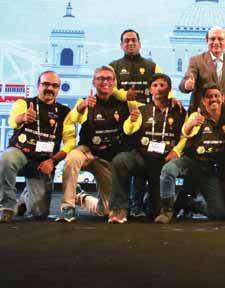
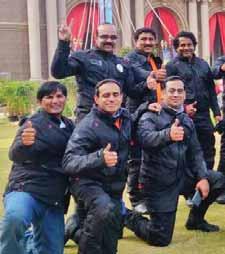
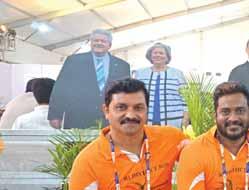

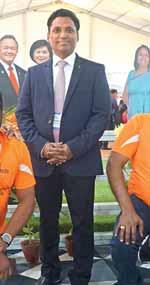
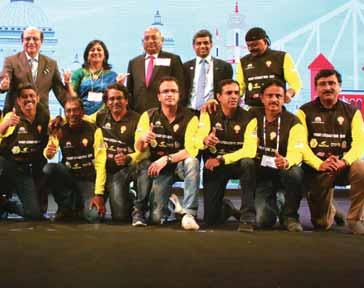

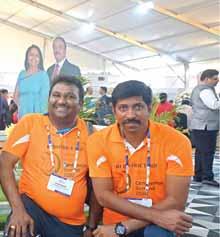

from and if they were studying somewhere. The children said that they were from Rajasthan, and that their parents didn’t have enough money to send them to school.
“I wanted to offer some money but was not sure if leaving money with the youngsters was a good idea.” He looked for their parents but couldn’t find them. He then offered them the flowers he was carrying from the previous day’s event. And the kids left happily.
“The Asha Kiran project that we are propagating is actually targeted to get such kids back to school. While the incident made
Clockwise: Sunil Telkar (kneeling L) and team from RID 3190 at the Kolkata Centennial Summit with RID Kamal Sanghvi, Sonal, PRID C Basker and PDG Rajendra Rai; D Ravishankar, past president, RC Bangalore Orchards; Ravi Manda (L) and his team from RID 3020 at the Summit after completing their ride; The RID 3190 team with D Ravishankar (standing fifth from L).
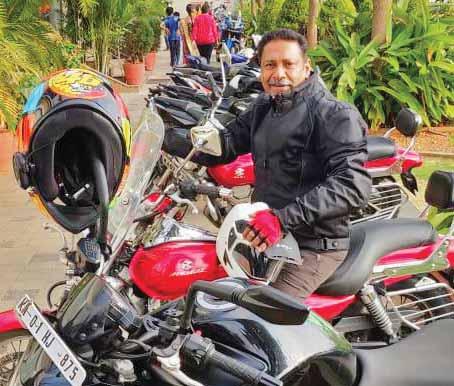
me sad, somewhere down, there was a sense of satisfaction that we were doing our bit to propagate the cause. My commitment to literacy projects just got strengthened,” said Telkar.
Ravi Manda, President of RC Vijayanagaram, RID 3020, with five other Rotarians from the district, along with an eight-member team from RC Chennai Meraki, an all-women’s club of RID 3232, and two riders from RC Sankagiri, on bikes and cars, reached Kolkata from Visakhapatnam in Andhra Pradesh. The rallyists were spreading Rotary’s public image along the way. “Many youngsters were interested. Some even asked if it is possible to join Rotary even if they didn’t have the money. And we explained that it is not just money, you can give your time and ideas too,” said Manda, who had a cast on his arm.
He met with an accident at Ichhapuram while riding with his wife Vani, also a Rotarian, on the pillion. Vani’s foot hit a rock and her ankle twisted while they were riding along a stretch where road repair was under progress. “She is in ICU in a hospital in Ichhapuram but persuaded me to finish the rally. As soon as we reached the venue, I showed her the photos on WhatsApp and told her, ‘It is your spirit that helped us complete the rally’,” said Manda.
Iam happy to say that I am also a Rotarian. Rotary has put me on a higher trajectory ever since I connected with it. I will cherish this great moment, being here on this momentous occasion.”
With these words Jagdeep Dhankhar, the Governor of West Bengal, addressed a gathering of 4,000 Rotarians from across 32 countries, inaugurating the Centennial Summit held recently in Kolkata.
Dhankhar was an advocate when Justice B P Beri took him as a guest to a Rotary club meeting. “Hailing from a small village in Rajasthan, the experience was overwhelming for me, but I was very much impressed,” he said, and recalled his association with PRID Sudarshan Agarwal in the 90s. “He guided me and I learnt the parliamentary practices from him. It was due
to his efforts we had invited Sabooji (PRIP Rajendra Saboo) to the Parliament. I was a federal minister then. The moment is still vivid before my eyes.”
Dhankhar continued his address with more thoughts about Rotary and its humanitarian programmes and quotes from the President’s message column published in Rotary News. He highlighted a thought from RI President Mark Maloney’s message — “In Rotary, none of us is an island. All of us are in Rotary together, whoever we are, wherever we are from, whatever language we speak or traditions we follow. We are all connected to one another — part of our communities and members not only of our clubs, but also of the global community to which we all belong.”
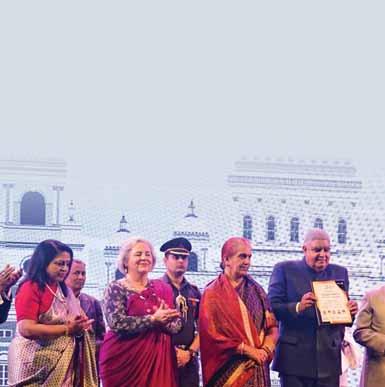
The philosophy of Rotary is a mirror reflection of our country’s age-old
civilisation. The focus areas and the Four-way test have a great similarity with our values, he observed and hailed RIPN Mehta on his new assignment.
“When he had called on me earlier, he promised that Rotary will sponsor 50 heart surgeries for children in honour of my visit to the summit. I was pleasantly surprised because this is the first time someone has come to give me something rather than take something,” he said amidst applause.
He recognised Rotary’s contribution for making India polio-free and thanked Rotarians for executing various welfare measures for the people. “We need more such hands to serve humanity and work for the uplift of people world over,” said Dhankhar and assured his unstinted support for Rotarians “as a foot soldier whenever you need my services”.
From L: West Bengal Governor Jagdeep Dhankhar and his wife Sudeshi being felicitated at the summit in the presence of (from L) Rashi, Gay, RIPN Shekhar Mehta, RI President Mark Maloney, RID Kamal Sanghvi and DG Ajay Agarwal.


V Muthukumaran
Celebrating diversity, attracting more youth to Rotary, leadership roles and having a strategic vision are some of the issues deliberated at a panel discussion on membership chaired by PRID Dr Manoj Desai at the Kolkata Centennial Summit.
In his opening remarks, PRID Panduranga Setty pointed out that while the growth rate was satisfactory in Asia, “it was a matter of concern in the rest of the world including N America. For a while we want to take the total membership of 1.2 million to the next level, but it never really happened.”
Trustee Jennifer Jones said the Vision Statement 2025 has given the right
emphasis on leadership roles in taking forward Rotary in the coming decades. “Embracing the Rotaract movement and Rotaractors is the right thing to do as they are fundamental to Rotary’s growth,” she said. Both the Vision Statement and Action Plan unveiled recently have focussed on four priority areas — expanding the reach, increasing engagement, more diversity and making membership affordable — which make Rotary an attractive organisation for less than 30-year-olds, who are more than half of the world’s 7.5 billion people, said Trustee Sang Koo Yun from Korea.
The young generation would affect the future of Rotary and “we need
While service activities are important, giving opportunities for leadership development is also crucial for drawing the youth.
Past RI Director Manoj Desai
to look at them carefully as part of demographic study. Their passion will drive Rotary’s membership,” he said. Rtn Sarita Mclean from Australia and New Zealand region said declining membership was a big worry in her zones.
RIDE Katrina Kotsali from zones 21A and 21B (Central Asia and East Europe) said, “Peace initiatives of Rotary are critical to draw young people into its fold in our region.” Giving a different perspective, RIDN Vicki
Puliz, RID 5190, US, said, “as our services are multifold, the youth look for leadership development, networking in Rotary as attractive elements.”
Desai summed up the session saying that district leaders must take efforts to understand their clubs’ needs. “While service activities are important, giving opportunities for leadership development is also crucial for drawing the youth,” he said. PDG Swapan Choudhury gave vote of thanks.
From L: RIDN Vicki Puliz, Trustee Jennifer Jones, PRIDs Manoj Desai, M K Panduranga Setty, Rtn Sarita McClean, Trustee Sang Koo Yun and RIDE Katrina Kotsali.


Who are the best leaders in the world and what traits would you want to emulate from them, asked PDG Deepak Kapur at a GETS training session at the Indore Institute.
A leader in any field of action must inspire and empower others, keep cool in a crisis, recognise good work, motivate and groom new leaders, said Kapur. “At the same time, one should be humble and self-confident.” While the purpose of Rotary districts is to support and strengthen clubs, they also act as a bridge between RI and Rotarians; the DGs have to strike a synergy between their clubs through fellowship and events that bond professionals from diverse backgrounds.
Those clubs that keep themselves aloof and don’t attend district events and other group activities, should be given responsibility; “involve them in training sessions and keep a watch on their monthly activities,” said Kapur.
Another challenge is to manage the conflicting leadership styles in a district hit by factionalism and power rivalry. “You should have mediation skills to overcome tussles between district leaders.”
Breakaway sessions discussed how to tackle conflict situations in district clubs and between district officebearers. A clutch of problem-solving ideas were aired: a Performance Committee Chair to acknowledge the good work, or a Conflict Management
Committee to go into these conflict issues; the DG can appoint a facilitator to examine issues creating problems; and the communication channels with the club’s core team must be strengthened to remove their negative perception and identity crisis.
Summing up the discussion, Kapur said as future governors they should devise strategies to handle conflicts and keep all clubs working in unison for the betterment of their communities.
In another session for DGEs of zones 5 and 7, PDG J B Kamdar emphasised the need to communicate and connect with
clubs. Social media can be leveraged effectively to create greater impact with clubs. WhatsApp, Facebook, YouTube, Rotary.org, GML (digital), district website, email, blogs, Instagram and webinars could be used to keep Rotarians motivated to do bigger projects. “Conventional platforms such as print media, brochures, pamphlets and GML newsletters still hold relevance. Plan your OCVs (official club visits) well in advance by consulting the assistant governors, club president and secretary to know the projects they are doing, status of membership and TRF giving for a quick preview of their work,” he explained.


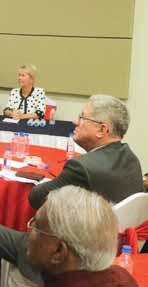
RID Bharat Pandya at the Regional Leaders Seminar. Also seen are PRID C Basker and Trustee Jennifer Jones.
As future governors they should devise strategies to handle conflicts and keep all the clubs working in unison for the betterment of their communities.
INPPC Chair Deepak Kapur
District website
On a scale of 1–10, how important is your district website? All DGEs agreed to a ranking of 8–9 and recommended regular updates of club events, projects and additional tools to make it easy to navigate. The club’s history, and a photo gallery could be added. DGE S Muthupalaniappan, RID 3232, said links to RI websites could be given on the district portal for sharing notes and uploading projects. DGEs Ranganath Bhat, RID 3181, Sangram Patil, RID 3170, Dr Thomas Vavanikunnel, RID 3211, and K S Venkatesan, RID 2982, agreed that district websites can become powerful digital tools to galvanise club activities and enhance fellowship.
Revamped GML
While soft copies of GML could be sent to all members, hard copies need to be
posted to district leaders. Apart from district projects, the monthly newsletter must shed light on membership, TRF giving, major donations and Foundation activities with relevant figures, said Kamdar.
Continuous learning must for Regional Leaders
New priorities have replaced old strategies to increase Rotary’s impact, expand its reach, deepen the engagement of participants and enhance the ability to adapt to the tectonic changes in the world, said Nora Beamish, support staff, Regional Leaders programme, Evanston.
While the website Rotary.org is used to store training resources, the new action plan focuses on building agile teams of Regional Leaders (RRFCs, ARRFCs, EMGAs, EPNCs, DRFCs, RPICs and Trustees) who are able to develop a strong rapport with RI districts, she said at a seminar chaired by PRID C Basker at the Indore Institute. “Regional Leaders need to engage more, provide tailored information and generate ideas to keep district leadership in tune with the new realignments of RI’s focus,” said Nora. Now that Rotaractors were elevated as part of Rotary; diversity, equity and inclusion were included in the new Vision Statement of RI.
Trustee Jennifer Jones who co-chaired the session, urged the RPICs to shore up the public image of Rotary as “most people don’t know who we are and what we do.” “Regional Leaders must include Rotaractors in image building, add more women members and ensure flexibility of clubs in conducting their weekly meetings,” she added.
EPNC Dr E K Sagadhevan gave an overview of Project Positive Health — Stop NCDs, a pan-India initiative that aims to check the epidemics of obesity, hypertension and diabetes through a graded three-step approach by Rotary.
“Each person must know his or her body mass index, BP and sugar levels for which clubs will issue Rotary ID cards at special NCD camps,” he said.
Apart from the Ek chammach kum, char kadam aage — One spoon less of salt, sugar and oil, take four steps forward — campaign, Rotarians will support the wellness initiatives of the governments and play a strong advocacy role, besides taking awareness programmes such as rallies, special camps and NCD sessions in schools, said Sagadhevan.
Pictures by V Muthukumaran
V Muthukumaran
Amit Mitra, Minister for Finance, Industry and Commerce, West Bengal, placed three suggestions for Rotary in the fields of healthcare and enterprise during his speech at the Humanity Hero Awards session at the Centennial Summit.
He urged Rotary to set up three more x-ray diagnostic centres as the first one with ultrasound, haematology
and ECG machines has surpassed expectations in treating needy patients. “Over 150,000 patients have benefitted in the last four years at this centre which charges 40 per cent less than the market price. I restarted the bus service which used to drop rural patients at the doorstep of the x-ray centre which employed 27 people. Now, it has a surplus of $200,000 which is deposited in the bank,” Mitra said.

West Bengal Minister for Finance, Industry and Commerce Amit Mitra being honoured by RIPN Shekhar Mehta as PDG Subhash Jain and Centennial Summit Chair Vinod Bansal look on.
RIPN Shekhar Mehta intervened and said that Rotary will set up, not three, but six more diagnostic centres in the near future.
Following the lead given by Rotary in paediatric heart surgeries — 1,000 done in the centenary year — the minister said that the government has given priority to Shishu Sathi, a healthcare scheme that offers free heart surgeries to children.
Mitra lauded Rotary for taking diverse projects worth $30 million ( ` 200 crore) in 2019–20 across Bengal, and called upon clubs to scale up projects at the grassroots level.
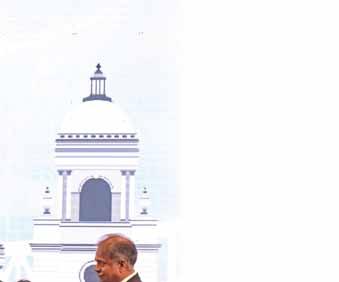
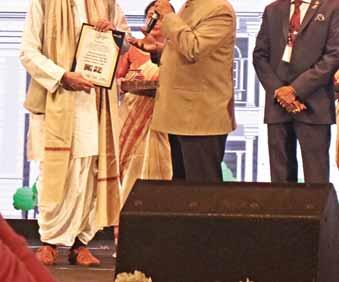
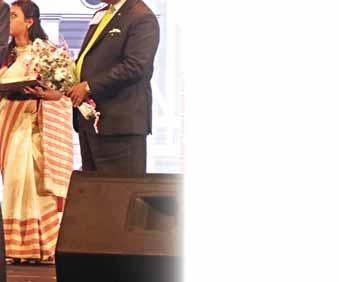
His second wish on his bucket list was on the MSME front; the Minister urged Rotary to create a special cell for MSMEs attached to the ministry that can skill micro and small entrepreneurs, mentor and help them find export markets. “With your expertise, you can help them to scale up their work, guide them to expand their business. We have set aside `70,000 crore for the growth of the MSME sector having 900,000 units in the State and any proposal from Rotary will be cleared by me in no time,” he promised.
Thirdly, there are 549 industrial clusters in West Bengal and “Rotary can adopt and nurture at least five of them, particularly the tannery and leather cluster which is the largest. We will extend all support to your initiative.”
He hoped Rotary projects across the State would touch `500 crore in the next three years and called upon Rotary leaders to take the lead in creating jobs in West Bengal.

V Muthukumaran

Ninety-nine years ago at the RI Convention in Edinburgh, a resolution on International Standards on Goodwill and Peace was adopted, which laid the foundation for a slew of resolutions on human rights and global peace at future conventions. When US President Harry Truman and British PM Winston Churchill came together to draft the UN Charter in San Francisco in 1945, after the World War II, there were 49 Rotarians on the drafting committee, said RIDE Peter Kyle, RID 7620, Washington DC.
Chairing a panel discussion on ‘Promoting peace: Making dreams real’ at the Centennial Summit, Kyle said Peace and Conflict Resolution is one of the six Focus Areas of Rotary and a number of initiatives are taken up including workshops, conferences, Rotary Peace Chairs, Peace Fellows and Peace Academies to achieve one of the primary goals of RI. “Peace is in Rotary’s DNA and our 1,350 Peace Fellows are spread out in the world and are passionate about their missions,” he said.
DIG Luish Aind, an IPS officer from Guwahati and a Peace Scholar
from RID 3240, said overseeing the laying down of arms by over 2,000 Bodo militants gave him immense satisfaction. His batch of Peace Scholars is active on social media which helps them to alert the public against fake news and disinformation campaign by vested interests.
“But rehabilitating all the surrendered militants into society is a challenge,” he said.
PDG Kalpana Khound, RID 3240, said the North-East region from where she came is a hotbed of militancy and conflicting tribal interests and the vulnerable youth are attracted by extremist groups who share their same ethnicity, language and culture. “Rotary Peace Centres have a great role to play to forge sustainable peace in the North-East. The porous borders make it easy for unemployed people to engage in anti-social activities, creating unrest,” she said.
PDG Aziz Memon, TRF Trusteeelect from Pakistan, recalled that at a recent debate in Cambridge University it was pointed out that “absence of war is not peace” and sustained
efforts are needed to achieve results on the ground. “Our efforts to eradicate polio in Pakistan and Afghanistan have to face many setbacks due to killings and terrorist violence. Around 70 per cent of our frontline vaccinators are girls and over 190 of them were killed in the last three years at the Swat region during their polio work,” Memon said.
Pakistan was successful in rooting out smallpox way back in 1968, thanks to the absence of terrorism at that time, he pointed out.
Saloni Lakhia, a Rotary Peace Fellow, said in the last six months after “we had passed out, we are sharing resources, contributing to research papers and looking out for collaborations across the border.” All the 25 Peace Scholars in Mumbai help in “designing club projects as they are among the think-tanks,” said Rajendra Ruia, District Avenue Chair, Peace Fellowship, RID 3141. They also interview candidates with leadership skills and get exposure to peace-building efforts through active involvement in community activities, he said.
Kiran Zehra
Fun is the right epithet for a one-word description of Junoon, RID 3250’s district conference in the City of Nawabs, Lucknow, as over 800 Rotarians with their families participated in the event to reminisce their achievements, and enjoy a weekend together. The discon was attended by RIPR Francesco Arezzo, RIPN Shekhar Mehta, RIDs Kamal Sanghvi, Bharat Pandya and RIDN AS Venkatesh. Amidst the sounds of trumpets A m id s t th e soun d s o f t rumpe t s and drums, the Rotary leade rs were c h au ff eure d in carriages drawn
by horses and welcomed with a traditional arti
In his inaugural address, RIPR Arezzo asked the Rotarians to “apply the Four-Way Test in your personal lives and business. Work hard, preserve the past, cherish the present and make way for the future.” He acknowledged the major donors for their support to The Rotary Foundation and congratulated DG Gopal Khemka
for increasing the number of women Rotarians in his district.
RIPN Mehta reminded everyone that a district conference “presents an opportunity to make new friends, revive old friendships, learn from our seniors and bond with the youngsters of our organisation.” His greatest achievement in Rotary, he remarked, was that, “I never said ‘no’ to a task or responsibility given to me.” This, he said, opened gates for bigger responsibilities and helped him understand the true essence of Rotary and its purpose.
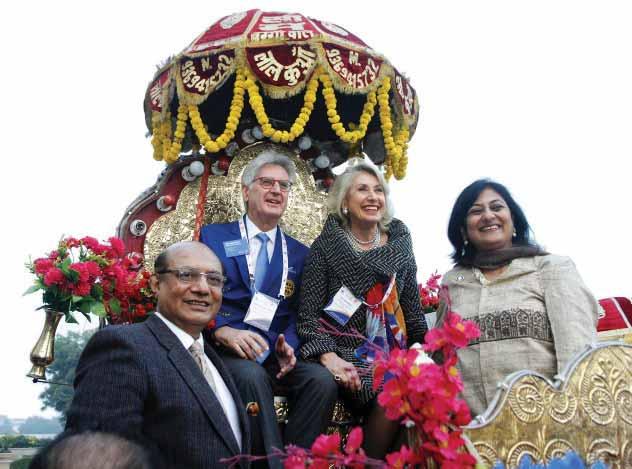
In an eloquent sher-o-shayari style, RID Kamal Sanghvi gave a
RIPR Franceso Arezzo and his wife Anna Maria being given a grand welcome to the district conference. RID Kamal Sanghvi and Sonal are also in the picture.
From L: Avita and DG Gopal Khemka along with RIPN Shekhar Mehta and Rashi.
lyrical touch to his motto ‘Each onebring one’. “To make Rotary stronger it is important that we make our sons and daughters proud Rotarians,” he said. He praised the women in the hall who “either in the capacity of Rotarians or as Anns are doing a commendable job in making Rotary stronger.”
RID Pandya said, “the true strength of Rotary comes from

Rotarians working sincerely in their clubs and communities.” He stressed on membership growth, retention and partnership with other organisations, government and other NGOs to carry out meaningful service projects. He reminded Rotarians about the importance of good health and how it played a key role in achieving the aims and objectives of our life.
To support digital learning in Kannada language and help students in understanding various subjects in their mother tongue, RC Bangalore Oasis, RID 3190, has introduced a multilingual keyboard which will enhance computer literacy at the Government High School, Rajanukunte.
The versatile keyboard called Ka-Naada was installed at the language lab in the school. “Ka-Naada is a smart keyboard facilitating multilingual typing for Indic languages
RIDN Venkatesh talked about the need for literacy and stressed on the significance of E-learning and adult literacy.
The discon was packed with fun and fellowship along with interesting sessions. DG Khemka in his closing remarks thanked his home club RC Pataliputra and acknowledged everyone who made the discon a success.

and has Roman alphabet character sets for English language,” said Paul Mundackal, the club’s Community Services Director. The device, developed by Dr Guru Prasad of KaNaada Phonetics, comes with a low-cost pocket computer to enrich the learning experience of students.
This keyboard will enable a child to type words and sentences right from Class 1 in his or her mother tongue.
The students at this school have now started typing in Kannada, using the multilingual keyboard and also
type other Indic languages using Kannada as well. “They also learn and type English. Many students hadn’t even touched a mouse earlier. Now they have a feeling they are not left behind in the digital world,” he said.
The club is revamping the school building, providing new benches and training teachers and students on various aspects of critical thinking. “WinS programmes are being held and reusable pads are distributed to girl students,” said Club President Hemant Sharma.
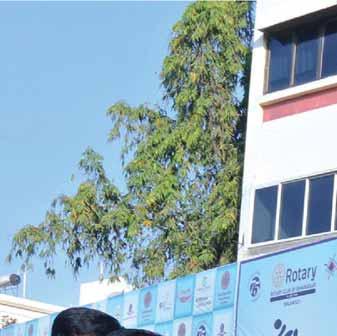

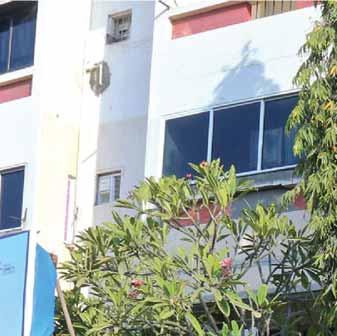
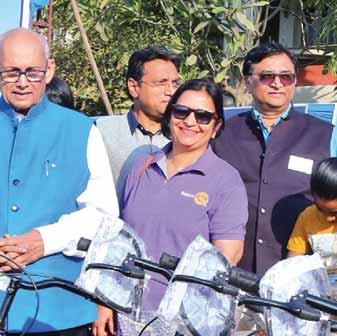







Rasheeda Bhagat
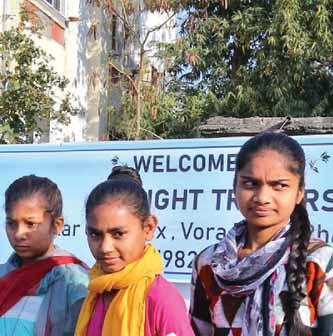
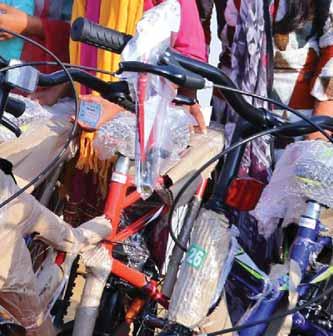


RC Bhavnagar was born on Valentine’s Day in 1945, and celebrated its platinum jubilee this February. Says Manish Kothari, past president and event chair, “Since then, and for the last 75 years, our club members have been living the Valentine spirit through love and service for the downtrodden of Bhavnagar district.”
He says that all the 131 members of his club, the sixth oldest and one of the largest in RID 3060, have always thought of “creative ways to deal with old problems, and more importantly, think in advance how to solve problems, even before we are approached. This foresight has built Rotary’s image in our city. Our club also owns a beautiful airconditioned, acoustic sound-proof hall, from where we plan and execute centralised community service activities.”
The club marked its 75th birthday by organising a two-day mega celebration event, presided
over by PRIP Kalyan Banerjee and attended by DG Anish Shah, DGN Santosh Pradhan, IPDG Pinky Patel, and PDGs Pradeep Gohil and Deepak Agrawal.
The celebration of the club’s platinum jubilee began with a blood donation camp, where 100 bottles of blood were collected. The senior Rotary leaders were then taken around the club’s iconic projects. One of these was A Ray of Hope — a childcare project “which covers the longstanding and critical local need of educating and nourishing street children,” says Club President Rakesh Kanada. This project, on for 20 years, has received much recognition in the city and many of the children nurtured by it “have graduated and are in very good jobs,” he added.
Another project, Light their Path is a school bench project under which 4,300
For the last 75 years, the club members have been living the Valentine spirit through love and service for the downtrodden of Bhavnagar district.
school benches worth an impressive `90 lakh have been donated. The Rotary E-Library is “a unique state-of-art airconditioned library for college students.”
Amrutam is a water-harvesting project to recharge and rejuvenate wells, while improving the groundwater table, and at the Rotary Permanent Vaccination Centre, more than 300 children are vaccinated every Sunday by qualified doctors and nurses at subsidised rates for the last 20 years.
Another project, the Rotary Parekh Diagnostics is a medical pathological lab where tests are done by qualified and skilled personnel at reasonable rates.
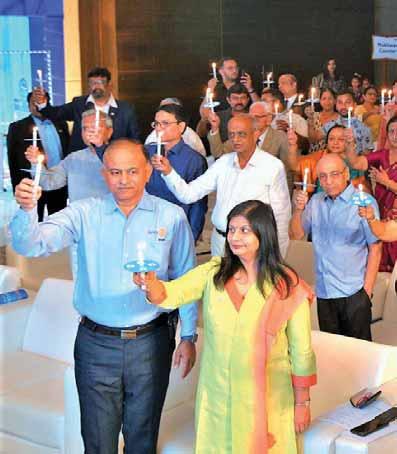
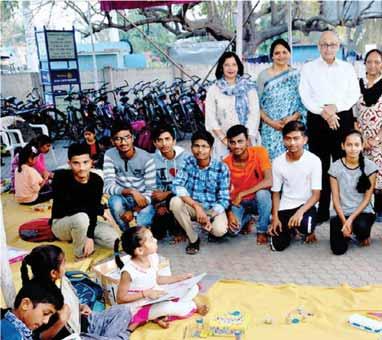

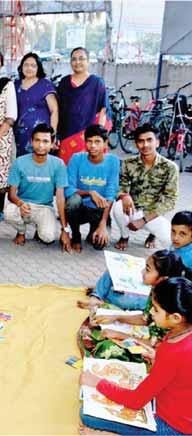
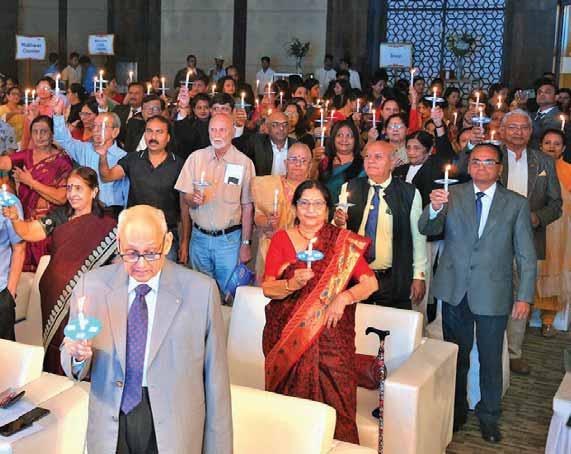

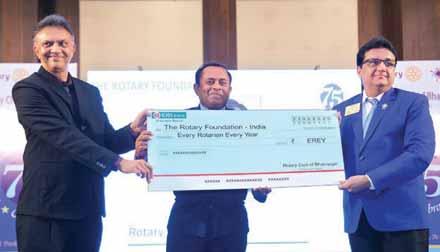
PRIP Banerjee congratulated the club for its great work in meeting the community’s needs with sensitivity, empathy and effectiveness.
A grand celebration was organised late in the evening with flags and candles. Apart from the district’s senior leaders, it was attended by the city’s dignitaries and leading citizens, donors, Rotaractors and families of club members.
Kothari, who is also the TRF Chair of his club, added that in this landmark year, the club has launched a scheme titled EREY— Every Rotarian Every Year. This is to encourage all its members to donate to TRF every year. “This year we will donate 131x $100, or $13,100 to TRF and we handed over a symbolic cheque to our DG Anish Shah on this occasion.”
The next day, a spectacular PR and public image exercise was held in which a whopping number of 5,000 youngsters wearing blue T-shirts and caps with Rotary logos participated in a Cyclothon. “We’ve been doing this for the last 10 years and through this sending out a strong and symbolic message of Green Bhavnagar,” said Kothari, adding that to mark this landmark, the club gave out 75 new cycles to needy schoolchildren.
Designed by N Krishnamurthy
As RC Madras South (RCMS), RID 3232, celebrated its diamond jubilee, women members stole the show wearing grand pattu sarees, with the malli poo ( jasmine flower) in their hair filling the rooms with a delicate fragrance. The 60th anniversary event was packed with fun and entertainment shows performed by Rotarians, Interactors, Anns, and Annets.
Chartered on June 30, 1960, this is the second oldest club in Chennai and
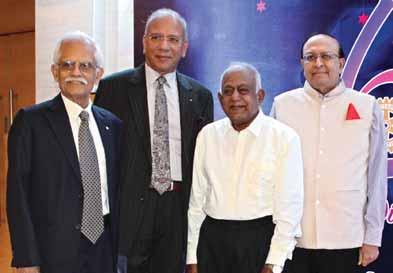
has sponsored four Rotaract clubs and five Interact clubs.
“You have achieved this milestone through hard work and dedication of your members. It is wonderful to see this club having a strong sense of family togetherness celebrate its 60th anniversary,” said TRF Trustee Chairelect K R Ravindran and reminded the club that “while you celebrate, make sure you focus on your efforts to make the next 60 years even more impactful and successful.”
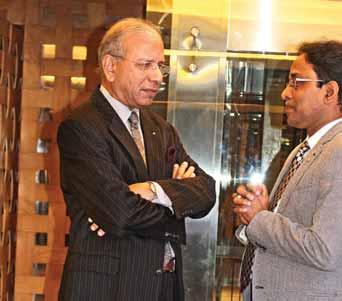

TRF Trustee Chair Elect K R Ravindran with DGE S Muthupalaniappan.
Ravindran released the Special Diamond Jubilee book edited by club member S R Madhu. DG G Chandramohan read out a citation for a special award ‘Doyen of the District’, that was conferred on PDG Ramakrishna Raja. The DG congratulated the club and said, “You are a strong club. Whenever we have asked your club for an opinion on any Rotary matter, no different opinions are given. You have one voice and this is very rare nowadays. Keep up the good work.”
Ten foreign delegates from Austria, the Netherlands, and Rotarians from RC Pasadena, the US, were honoured for partnering with the club in its Caring for Little Hearts project. Under this global grant project, free heart surgeries were performed on 225 children from underprivileged families with congenital heart disease for two years till 2019.
Praising the project, Ravindran said, “This shows what we can do in Rotary when we approach the business of service with our full attention, our full expertise, and with a full heart” and added that a lot more can be done through partnerships.
Club President M C Srikanth thanked TRF and the partner clubs
From L: Club President
M C Srikanth, TRF
Trustee Chair Elect K R Ravindran, Editor of the Diamond Jubilee book Rtn S R Madhu PDG G Chandramohan and Club Secretary R Rajan Babu.

for their “progressive support. We are confident that with our dedicated members and your support we will be able to touch more lives.”
Past members of the club were invited on stage in three batches after an audio-visual highlighted their personal, professional and Rotary
Team Rotary News
Nearly 250 people who had lost their hand either by accident or since birth got prosthetic hands at a mega LN-4 hand fitment camp organised in Meerut by RC Meerut Virat, RID
careers. It was nostalgia tinged with sadness when Anns of Rotarians who have passed away were recognised. Some of the milestone projects — the expansion of Kumaran Special School, tailoring classes for underprivileged women at Kattur, the club’s adopted village, and its
rainwater harvesting initiative — were highlighted to mark the special occasion.
PRID P T Prabhakar, PDGs Krishnan V Chari, P T Ramkumar, G Olivannan, I S A K Nazar, Natarajan Nagoji, C R Raju, and DGE S Muthupalaniappan participated.
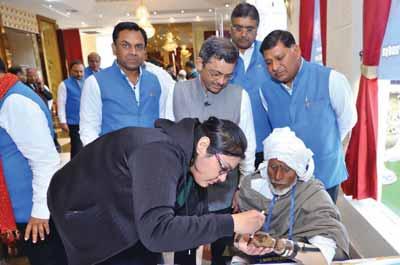
RID Bharat Pandya looks on as a volunteer teaches a beneficiary to write with his LN-4 arm.
3100. RID Bharat Pandya who visited the camp appreciated the Rotarians for the endeavour and urged them to execute bigger projects to give sustained benefit for a larger community.
Club President Sameer Agrawal said that the club members worked for 10 months to diligently identify the beneficiaries from around the town and trained them to put their new ‘hand’ to proper use.




banning the books is rooted in religious dogma. They refuse to accept the argument that the series has more to do with magic and fantasy rather than occultism or satanic cults. The books are banned in all schools in the UAE, for instance, although they can be found in bookshops there, according to reports. Some churches in the US are vociferous in their denunciation of the books, as also in pockets of Bulgaria and Greece.
AWhy do some books raise so much dust? What are we so afraid of?
s governments around the world react in a panic to the speedy dispersal of the corona virus, bans have been issued to travel; colleges and universities have declared long breaks with some of them postponing exams; conferences have been cancelled. There is one silver lining, though: this is resulting in a major reduction of carbon footprints because it seems there’s really no better solution than simply sitting put. And sitting put always gives me the hope that in between working from home and putting social media on overdrive, some of us will turn to books: pick up that one book you always wanted to read but just didn’t get the time? This is a good time to catch up on reading. There’s so much interesting stuff being published on a range of subjects that you are bound to find something that will interest you. When Harry Potter first hit the scene, there was a massive buzz across the world, partly due to some terrific marketing strategies but equally due to compelling writing by J K Rowling. People who
had never read anything before now began to be seen in ‘places that must be named’ clutching fat-fatter-fattest copies of the series. Although that frenzy has now died down, HP continues to do well. Yet….
Yes, yet, the Harry Potter books are banned in some schools in the US because it supposedly propagates sorcery and witchcraft. Stands to reason, though, because it is precisely about kids studying at a school of sorcery and wizardry. The reasons for some schools and even countries



What does Rowling herself have to say about all this hoo-haa? Back in an interview with CNN in 1999, she declared, “I absolutely did not start writing these books to encourage any child into witchcraft. I’m laughing slightly because to me, the idea is absurd. I have met thousands of children and not even one time has a child come up to me and said, ‘Ms Rowling, I’m so glad I’ve read these books because now I want to be a witch’!”
Apparently, the reason for the ban is that it talks about sorcery and magic and these are no-nos among certain communities. Well, since most of the action takes place in a school for magic and wizardry, where quite naturally wizards abound, this isn’t surprising. Although, in a way, it is, isn’t it?


If Harry Potter could invite fatwas, is it surprising that The Satanic Verses did, forcing its author Salman Rushdie to go into hiding for around ten years after Iran’s Ayatollah Khomeini called for his death on the grounds that the book was offensive to the Prophet. When the succeeding government of President Khatami announced that it no longer supported the killing of Rushdie, he emerged from hiding with the manuscript of a new book called Joseph Anton, his alias during the ‘incarceration’. The fatwa, however, is still floating around.





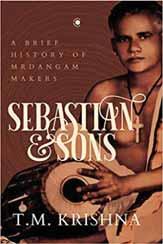

superiority; from alternative stories of makers from Andhra Pradesh and Kerala to the alterity of the few women makers in the business — and the spectre of caste inhabits each of these accounts, adamantly, every step of the way.” The stories and anecdotes recounted are a delightful and insightful account of social history; they unravel “the complex web of social institutions thate lie beneath the relationships between master musicians (usually Brahmins) and master craftsmen (many of them Dalit Christians) of the mridangam”.

‘communist’ sentiments and portrayal of working conditions. George Orwell’s dystopian Animal Farm (1945) was confiscated in Germany by Allied troops, banned in Yugoslavia in 1946, in Kenya in 1991, and the UAE as recently as 2002. Alice Walker’s The Colour Purple was considered sexually explicit and its language offensive. Tasleema Nasrin has been exiled for her writings.
The most recent book-related controversy occurred just a couple of months ago with the publication of classical musician T M Krishna’s book on mridangam-makers, Sebastian & Sons. Slated for an official launch at the prestigious Kalakshetra Foundation in Chennai, the function was upended by the management rescinding permission for the event because of its discomfort with the questions of caste raised in the book. In light of the fact that caste discrimination is alive and well particularly in the classical arts, and that we continue to play ostrich to this issue, Sebastian & Sons was bound to raise dust.
As Deshpande points out, a work such as this encourages us “to re-evaluate our understanding of the aesthetics of our practice” reminding us that “traditional ideas of beauty … are products of human endeavour and have therefore been and continue to be shaped by ideas of caste, class and gender”.
Musicians, their families, connoisseurs, the entire fraternity has been ‘shook-up’ by the book: time will tell us more.

Srijan Deshpande succinctly describes the crux of the controversy in a review he wrote for scroll.in. He writes: “Sebastian & Sons is an unabashed exploration of the workings of caste discrimination through a case study of the mridangam, the percussion instrument that is fundamental to Carnatic classical music. The twelve chapters of the book take us … from detailed, illustrated accounts of the skin-work, woodwork and stone-work that go into the making of the mridangam to debates about tonal purity and aesthetic

Back in 1939, John Steinbeck’s The Grapes of Wrath about tenant farmers forced to leave Oklahoma for California owing to economic pressures won a Pulitzer, but it angered many for its supposedly

Then there’s the classic case of Lolita (1955) by Vladimir Nabokov about a middle-aged man obsessing over a 12-year-old. Today, it is considered a classic piece of literature; then it was banned by many countries, including France, Canada, England, New Zealand, South Africa, and Argentina, for being ‘obscene’. J D Salinger’s The Catcher in the Rye (1951) describing three days in the life of a 16-year-old boy still raises censorious hackles even though the best librarians routinely recommend the book to young people, despite its generous use of colourful expletives.


Some books will always generate controversy, particularly if they are themed on sensitive subjects. That’s natural, that’s the consequence of having a voice. But when we declare that certain books must cease to exist for whatever reason, that’s when we need to sit up and think again. In the end, the reasons for books being banned are political, or rather, fear on the part of political agencies that what the books say will influence the people the political agencies wish to keep on a tight leash. It’s a fascist tendency and is the reason we must reject bans on books. It is our fundamental right to choose to read or not to read. But no one has the right to tell us what we may or may not read.


The columnist is a children’s writer and senior journalist.


V Muthukumaran
Rotarians and Rotary clubs must scale-up their vision, dreams and project size and rather than just limiting themselves to doing community programmes, they have to look beyond to take up global projects as lead partners,
be relevant with the tremendous changes in technology and demographics. The weekly club meetings, networking and small, charitable activities may not be attractive for young professionals to join a club,” he pointed out.
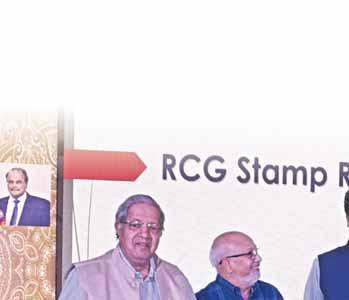
take up as lead partners, said RIDN A S Venkatesh, speaking at the 25 charter nite celebration of RC h Guindy, RID 3232 . “We need a change of mindset and think out-of-the-box to will set in if the
Fatigue will set in if the weekly club meetings are not made interesting.
“We must have a ‘strategic plan’, the current buzzword in Rotary, and one way forward is to scale up our work by
“We must have a the current buzzword in and one way forward is to scale up our work
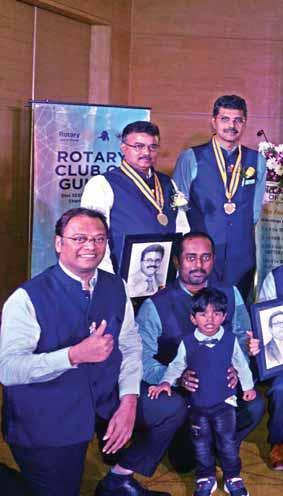




From Left: PDGs Krishnan V Chari, A Subramaniam, RIDN A S Venkatesh, PDG Sampath Arumugam, past president Sathish Kumar and RC Guindy President R Sivaraman releasing a postal stamp to commemorate the silver jubilee of the club.


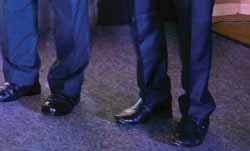
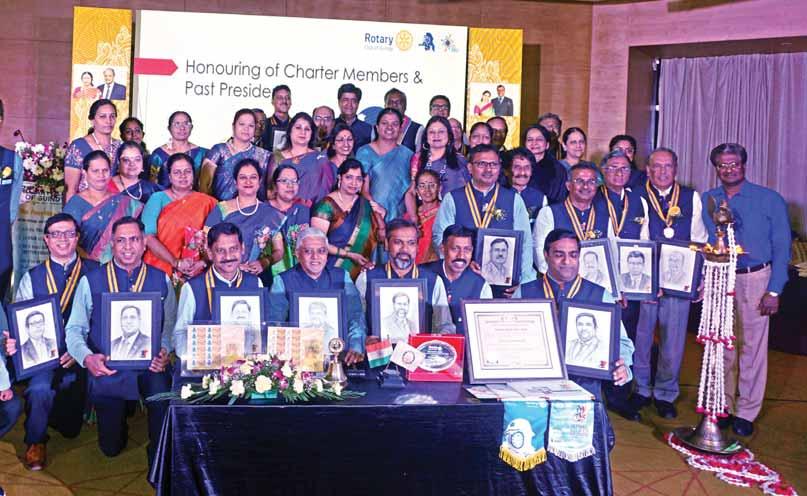
looking for overseas projects. Surely, RC Guindy can take projects as lead partner in Bangladesh or Nepal and in the next 25 years, by 2045 one can look back and say ‘a job well-done’,” he explained. Instead of refurbishing classrooms, plan for constructing a school, and go for a new hospital, rather than holding regular medical camps, he advised the Rotarians.
Turning 25 is a time to rejoice and the club has delivered many notable projects with a good track record in implementation, especially its Kottivakkam Dental Centre and its engagement at the Hoina orphanage, he said. The RIDN recalled how when he turned 40, and didn’t know what was in store for him, “my wife Vinita brightened up my day with a a beautiful cake in the form of a bridge table to cheer me up. She told me: You are not getting old, but you are getting right.”
Shifting his focus on disaster relief, Venkatesh urged the club to take the lead in distributing shelter kits being
provided by Rotary India to the victims of natural disasters. “Perhaps you can select 4–5 locations in South India to store the shelter kits which can reach the destinations without any delay after the disaster strikes,” he said. Venkatesh conferred RCG Rathna Award to T Stalin Gunasekaran, President, Makkal Sinthanai Peravai, for his service to society. The awardee is a motivational speaker, author and social activist and has received national and global honours for being a “progressive change-agent in society.”
The club contributed $12,000 for TRF at the Charter Nite, taking the total contributions to $20,000 so far as against a target of $50,000 for the year. The charter members were felicitated with a special collar and portrait sketch on the occasion.
Formed on Jan 10, 1995, RC Guindy had 40 charter members and A Ramanujam was the charter president. Most of them were alumni of the College of Engineering Guindy
and had set up offices or factories at the Guindy Industrial Estate. Club President R Sivaraman briefed the gathering on some of their milestone projects — Mathur Government High School, a community hospital at Alathur village and a global grant project for medical facilities at the Sankara Netralaya Eye Hospital.
On an average the club is doing around 14 projects a year with a membership of around 100. It has sponsored four Rotaract and four Interact clubs. Foreign delegates, R Janarthana Naidu and his spouse M Mageswari Muthaiah from RC Alor Star, and Dr S Rajesh from RC Bandar Sungai Petani, both the clubs from Malaysia, RID 3300, were special invitees to the event. A commemorative postal stamp was released to mark the silver jubilee. DG G Chandramohan, DGE S Muthupalaniappan, PDGs I S A K Nazar and Natarajan Nagoji were felicitated by Club President Sivaraman. Pictures by V Muthukumaran
Bharat and Shalan Savur
Asage was asked, “How will I know I am living my truth?” The sage answered simply, “When you are relaxed about it.” If you want to know your truth, ask, “What am I relaxed about? What makes me feel relaxed?” When you have an activity or a hobby that makes you feel good, then it’s easier to do things that you have to do and when adversities crop up, you are better able to deal with them.
Your hobby is your prayer or meditation. It can be the other way around too. Your prayer can be your hobby. A hobby tempers your energies with clarity, it also helps your natural exuberance to find fruitful expression. When engaged in a hobby, there is immense peace in and around you. It is a special peace, not the peace of death, but
the peace of life. You can literally feel this peace as a pleasant sensation in the back of your head, it’s a tangible presence and it’s calming.
It’s like filtration . All the energies have been filtered and are clear and transparent. You become as pure as an infant. Look into the eyes of the child — two clear pools of acceptance, a smile lurking in the corners, and when the gaze is turned away from you and directed to the ceiling, you feel a sense of loss. An infant is pure because it has no agenda. Similarly, when there is no agenda tied to your hobby, no commercial considerations, no expectations of returns like fame and fortune, you are more inclined to bless than to curse.
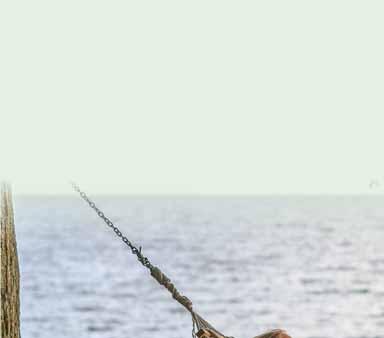
A hobby unhooks your mind from its everyday reactions — anger,
impatience and anxiety when something doesn’t go the way you want it to. Being absorbed in your hobby allows your mind to be in another dimension where an abuse sounds faint as if the abuser is at a great distance. It holds the mind in an enthralling present where you wait for nothing because waiting means you are straining to be in the future. In a hobby, the mind is so deep in a fascinating, fulfilling activity, that it cannot process anxiety, regret, resentment, self-pity and all those energy-debilitating feelings that lower the quality of our life.
Never ever lower the quality of your life. It is very easy to reduce it in the blink of an eye. One unkind word, one burning glare, one idle criticism and poof! down it goes. Consciously raise the quality of your life and consciously


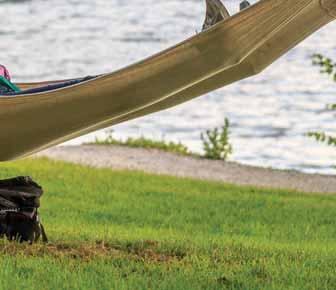
keep it elevated. You must already be aware that the brain controls the behaviour of all the cells in our body. It’s a wonderful coordinator. There’s one more important factor to be noted: almost all our body cells have the same neural receptors as the brain. It means our entire body is virtually a brain. Research has also shown that we can consciously use our brain to generate positive streams of thoughts, beliefs and chemicals to heal an ailment in the body.
Destructive and constructive interference. Stop activities that drain rather than enhance your energies. Have you spent time with a person who constantly complains and after she has left, you’ve felt drained of energy? It is because your entire body, rather, your entire mind-body’s cellular system experienced ‘destructive interference’ — as described in psychology parlance — like a series of pebbles thrown into a calm lake. So, the wise thing to do is to avoid people who generate poor quality vibrations that disrupt your natural harmony.


This is important because, otherwise, you too can willy-nilly get influenced into defeatist, blaming thoughtprocesses that drain energy. If you have no choice but to meet such people on a daily basis, please avoid asking them any questions. Even a simple “How are you?” can elicit a litany of complaints. Instead, take the lead and speak of positive things that have occurred, small miracles you have experienced, good news you’ve heard. Encourage them to repeat something wonderful that happened to them yesterday or years ago or five minutes back. The outcome is beautiful — two brains, two bodies, two neural cell systems focussing on the marvellous instead of the miserable. This approach is called ‘constructive interference’ by psychologists.
Positive social media. One medium which has destructive and constructive interfering qualities in it is social media. Here, before you read a negative forward further or tap the forward symbol to send it on to somebody, ask yourself: “Is this relaxing?” If not, delete it. Just delete the toxic ones without reading them. Why should they be allowed to mess up your mind? As one forward said, “Weak people revenge. Strong people forgive. Intelligent people ignore.” Ignore! Another says fittingly to this context, “Anything that costs your peace is too expensive.” It is.
Use social media to create a special people-to-people magic. In a curious modern technological twist, it has replaced the private ‘Dear Diary’ practice and is funny, crazy, boastful, insufferable, practical. It contains laughter and tears, hurt and outrage, philosophical and cynical stuff. Sure, it can and is abused, but for all that, it is a virtual UN of all kinds of people. You can be relaxed around it by just being yourself, by focussing on
the rainbows and wisdom it regularly screens. A word of caution: don’t let it overtake your personal relationships. Relax with the people you love, you are in harmony with while the mobile is tucked away is in some remote corner on mute. There’s nothing more relaxing and healing than being kind to yourself and those with you. As the Buddha said, “Be with someone who loves you for the days you don’t love yourself.” Be with someone you love and vibe with in a deep, loving, non-judgmental way.
Finally, one of the most beautiful ways to feel relaxed is to slow down the mad momentum of life. People who are hyperactive, pursuing several activities never arrive because they are already chasing the next activity. Jobs are rushed, decisions hurried, programmes aborted — nothing is allowed to mature, ripen and grow organically, not even the mind. Many activities are unnecessary, shallow, superfluous. They weaken our sense of discrimination, our ability to ask, “Does this relax me? Is this helping me?” It takes a master like Eckhart Tolle to advise, “Do few things but do them thoroughly. And allow some sanity to come into this world through you.”
It is true that life is about movement. But it is also about being relaxed in movement. Please start this healing practice: Sit quietly and allow contentment to rise and fill you. Stand quietly in the sweet, gentle breeze of love. Walk with long strides in the freedom of the spirit. Lie down in the silken waves of kindness. Sleep in the warm arms of reassurance. Draw the sense of relaxation into you as the river of life flows on.
The writers are authors of Fitness for Life and Simply Spiritual – You Are Naturally Divine and teachers of the Fitness for Life programme.
We would like to inform you that Rotary International, including Rotary Foundation (India), is implementing a new financial management system in 2020. An essential component of this implementation is a change in accounting for RF(I) from cash to accrual basis resulting in a modification in the way we will account for grants, their utilisation and income. Under the new system, we will require all clubs implementing grants that are currently open to submit the following documentation within the given due dates:
1. The bank certified/ printed version of the bank statement of the grant bank account from inception of the grant till March 31, 2020 by April 20, 2020.
2. In case the grant bank account is used by multiple grants, a grant wise reconciliation with the above bank statements by April 20, 2020.
3. Online report to be submitted via www.rotary.org by May 31, 2020.
4. A certified Utilisation Certificate, grant-wise receipts and payments statement and an interim report by May 31, 2020.
The information may be sent to Roy John at roy.john@rotary.org or reach out to 011-42250146.
How to contribute to RF(I)
Contributions from donors in India are received by RF(I) on behalf of TRF. Contributions can be made through cheque/bank draft/NEFT/ RTGS/net banking or directly through the Rotary website. All contributions
to RF(I) are eligible for 50 per cent deduction under section 80G of Income Tax Act, 1961.
Requests for reclassing prior year contribution from any Rotary Foundation fund, project or programme to any other fund, project or programme cannot be accepted and processed following the closure of that fiscal year, excluding secretariat administrative reclasses of a material nature.
Current year requests for reclassing will be accepted and processed if they are received within 90 calendar days of the gift receipt date.
Major Donor Recognitions
Major Donor status cannot be bestowed on an individual based upon support from another donor or donors or a “matched” contribution, either in part or in full, by a district, other entity or corporate.
In case of a contribution made by a family- controlled company or a family-trust, it may officially provide in writing that the actual credit be given to the owner or trustee of the trust. Only contribution by a spouse can be linked to an individual’s Major Donor Recognition. Merging of contribution from lineal descendants or ascendants (grandparents/parents/ siblings/children) do not count for Major Donor Recognition.
Bank/demand drafts should preferably include remitter’s name or carry a cover note confirming the donor name.
Mark of Excellence
Rotary clubs are now allowed to use the Mark of Excellence as a logo on their social media channels as long as the name of the club appears on the page. This will give clubs more uniformity on social media channels such as Facebook, Twitter, Instagram, while also being easy to use.
RY 2019–20 AKS members from S Asia as on Feb 2020
ZoneDistrictDonor NameRecognition Level
52982A K Natesan and ParvathyTrustees Circle
43011Suresh Jain and UshaChair’s Circle
73131Anil Jankidas Goel and Nirupama Trustees Circle
43141Baldev AroraTrustees Circle
43141Dilip Gopikisan PiramalTrustees Circle
43141Swati and Ajay G PiramalTrustees Circle 43141Nirav Niranjan Shah and Devina Nirav Trustees Circle
43141T N Subramanian and Vidhya Trustees Circle

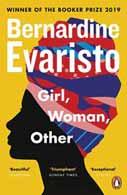
Author : Bernardine Evaristo
Publisher : Penguin
Pages : 457; `550
Thiswinner of the Man Booker Prize 2019, follows the lives and struggles of 12 characters mostly women, who are black and British. They share their personal journeys through the last hundred years of the country. They’re each looking for something — a shared past, an unexpected future, a place to call home, somewhere to fit in, a lover, a missed mother, a lost father, even just a touch of hope — so that they can tell the stories of their families, friends and lovers, across the country and through the years. Bernardine Evaristo brings to life generations of women and the people they have loved and unloved — the complexities of race, sex, gender, politics, friendship, love, fear and regret.

Author : Anabel Loyd
Publisher : Penguin Pages : 280; `401
Inthe seventy or so years since Independence, not much is written about the princely states which acceded to Pakistan. The name of the once great State of Bahawalpur is not well-remembered, unlike its peers over the border in Rajasthan.
This book is based on conversations with Salahuddin Abbasi, grandson of the last ruler of Bahawalpur who was born a year before Partition. Starting with the history of his state and his family, his memories throw light on the Bahawalpur princes from old records, letters, and the accounts of British travellers and civil servants. They also encompass a first-hand experience of the political life of Pakistan and Abbasi’s relationships with its leaders.
The nation has had a troubled history and from the microcosm of Bahawalpur, this account helps to join the dots of a more coherent view of Pakistan and its future.
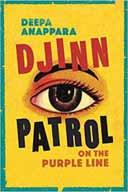
Djinn Patrol on the Purple Line
Author : Deepa Anappara
Publisher : Penguin
Pages : 368; `384
Nine-year-old Jai lives in a slum on the outskirts of an unnamed Indian city with his parents and older sister. In many ways he is an unremarkable boy: he watches reality cop shows on TV, attends the overcrowded government school, and tries to stay out of trouble. But when one of his classmates goes missing, Jai — taking inspiration from the TV programmes — turns amateur detective and vows to uncover the mystery of the disappearance. With the help of his two best friends — sensible Pari and diligent Faiz — they form a comical trio and set off on the city metro’s purple line to investigate.
Journalist and author Deepa Anappara draws our attention to the horrors and tragedy of the terrifyingly enormous numbers of children who go missing in India. Through Jai’s voice, she creates an endearing narrative that takes us through the dark underbelly of modern India.
Compiled by Kiran Zehra
Designed by Krishnapratheesh S

DG Zameer Pasha gave certificates to the third batch of 20 women for completing a tailoring course being organised by the club under a DDF grant.
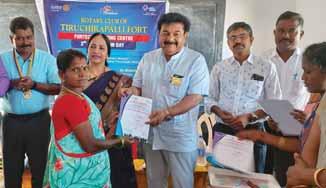
A health check-up camp was held for children of Future Pride Academy at the Batla Heart and General Hospital. They were screened for general ailments and given consultations.

DG N Manimaran inaugurated the ‘Honesty Shop’, a project the club is executing for the 20 years, to commemorate Gandhi Jayanthi. It is an unmanned shop and will function for the day. Public can take articles, put the money in a cash box and take the balance amount, if any, by themselves.
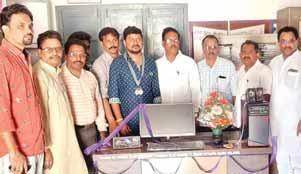
A computer system with accessories costing `1 lakh was donated to enhance a digital classroom at the Zilla Parishad High School at Konteru village in Palakol Mandal. The club has spent over `8 lakh for its adopted schools this year for providing notebooks, school bags, classroom furniture, lab equipment, computers, laser printers and other requirements.

Three computers with camera and virtual eye software were donated to the Blind School, Chalisgaon. The software would provide audio for reading textbooks for the visually-impaired children and has voice recording facility.
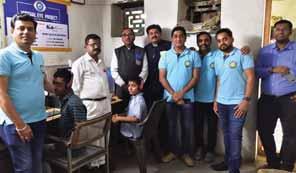

Warm clothes were distributed to elderly women in an anganwadi near Ganga Mandir. Under the club’s Chumantar programme, elderly, needy people were identified and given warm clothes and blankets to protect them during winter.
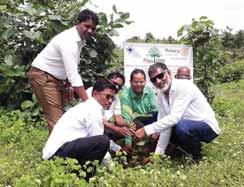

In its continuing efforts to create traffic awareness, the club has been pasting reflectors on E-rickshaws. In the first two phases, 100 reflectors were pasted on such vehicles.

An LED Smart TV was presented to a government school, Badhouchhi Khurd. Club President Ashwani Singh, Secretary Rajesh Chopra and Rtn Gopal Bimbrah sponsored the TV set which was handed over in the presence of Rotarians and school staff.
In a massive greening mission, the club planted over 10,000 saplings covering 33 acres across 17 locations. Club President R K Nair had initiated the project during his installation.
The club members trained two women with partial vision to make paper bags and helped them sell the 2,500 bags they made. DG Suhas Vaidya launched the project.

Two hundred kangaroo bags were donated to the Neonatal Intensive Care Unit at the Cooper Hospital, Juhu, to help mothers strap their low-weight, premature babies onto their chest to maintain a healthy body temperature for the newborns. These bags can be used by over 1,000 women as they can be sterilised and reused to reach out to more premature babies.
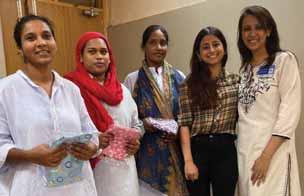
The club has upgraded the sanitation facility at the Bicholim Primary Rotary School by constructing four toilet blocks and handwash stations. More than 340 students benefitted from the project.

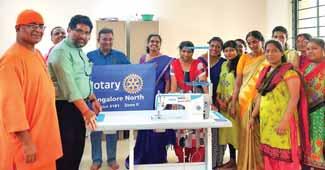
The club donated a sewing machine to Sharadha Training Centre on the premises of Ramakrishna Tapovana at Polali. The centre has been offering tailoring skills for needy women to help them earn a decent income.
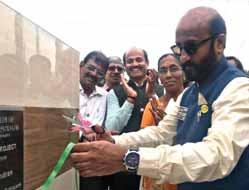
DG Madhav Chandran inaugurated three renovated classrooms at the Government Higher Secondary School in Pichanur village. A safe drinking water unit was set up at Government Higher Secondary School, Kulathupalayam.
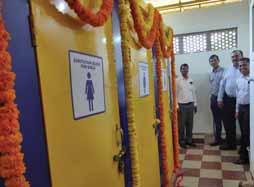
A three-wheeler costing `94,000 was given to Suganthi, a polio-affected person, to help her commute to workplace and back home. DGND Idhayam Muthu handed over the vehicle to the beneficiary.

Dustbin and tray filers were given to the OPD at the Government Pentland Hospital in the town. Bedsheets were provided to an old-age home at the Annai Teresa Convent complex in Shenbakkam.
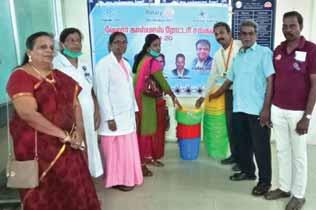

A dengue awareness campaign was launched in coordination with the Chennai Corporation. The residents took oath to keep their premises clean.
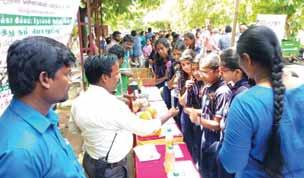
The Rotarians visited Narayanpur village and interacted with local doctors and health volunteers to understand the needs of TB patients. The club is holding TB awareness sessions for the last five years.

The club members planted 200 trees on the eve of Ganesh Puja at the Jharapada area. They also distributed 4,000 fruit and flower bearing saplings to devotees at the puja mandap in the presence of legislator Ananta Narayan Jena.
Compiled by V Muthukumaran Designed by L Gunasekaran
Just minutes before the final ride, sitting on her bike, Shoma Chakraborty, member of RC Thane Aces, RID 3142, tried to control her tears, stunned by what she had achieved by being part of her club’s initiative Ride for Bharat ke Veer . Not only had she, the only woman among 19 other riders, completed a 6,120-km rally across the country, she had also experienced “various cultures, traditions and the love of Rotarians from 100 clubs in the country.” The Rotary bike ride was to raise funds for the families of martyred soldiers, promote fitness across India and celebrate the Centennial year of Rotary in India.
RC Thane Aces, a less than twomonth-old club, wanted to do something meaningful and big, said Club President Mihir Patel. Chartered in June 2019, it has 23 members and “we worked hard to make this bike ride a success. But little did we know then that we would raise close to `33 lakh to support the noble cause,” he adds.
Little did we know then that we would raise close to `33 lakh to support the noble cause.
The club associated with various biking communities, fitness enthusiasts, the Indian Army and the general public for this initiative. At the curtain raiser of the project, 50 CRPF men were felicitated by the club followed by an introduction of the bikers and their travel plans.
PRID Ashok Mahajan congratulated the club “for taking up a challenging project.” Gallantry awardee Captain Binesh Nayar said, “It is such events by Rotary that make us believe that our families will be taken care of while we are fighting at the
border.” On the flag-off day, the riders met Union Defence Minister Rajnath Singh who praised the club’s efforts. “His handwritten letter of appreciation was the cherry on the cake,” said Patel.
DG Mohan Chandavarkar helped the club get in touch with DGs across the bike route and the meals and accommodation for the riders were arranged. “To make the ride costefficient we tried to get as many clubs to host the riders,” said Project Chairman Sanjeev Jain. While hoardings and posters were put up at vantage spots in Thane and Ulhasnagar, “our

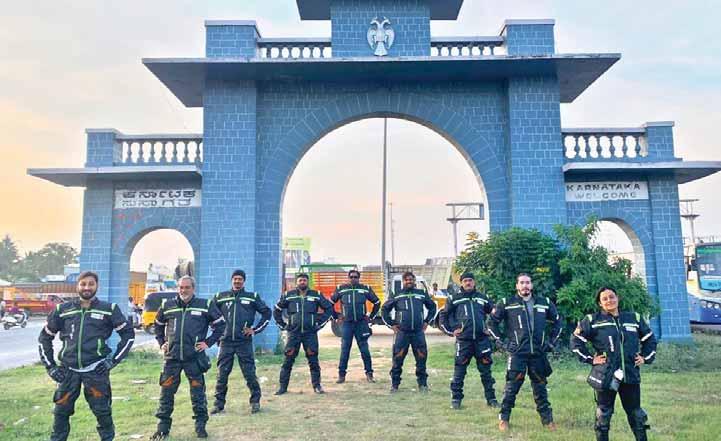
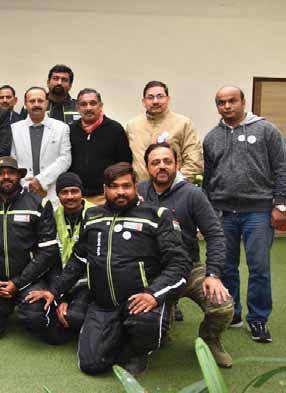
Rotaractors used social media to talk to other schools and colleges about the event,” Jain added.
Shoma pointed out that the ride involved spending long days on the bike, sometimes sleeping in uncomfortable places and eating indifferent food. “Although local, street food served on paper plates was delicious, it was hard to cope with the mental and emotional stress during our journey.” During the travel, the riders got appreciation for their good work by PRIP Kalyan Banerjee. His district, RID 3060, made sure they were given a warm reception from Valsad to Vadodara. “Coursing through the cities with a Rotary convoy, NCC procession and patriotic songs playing in the background,” are some memories Shoma will cherish. An amount of ` 500,000 was collected during the
journey from Rotary clubs and local donors, with RC Bangalore Indira Nagar, RID 3190, giving `150,000.
Besides, the riders exchanged their club flags with 80 other clubs. Rajashree Birla, Chairperson, Aditya Birla Centre for Community Initiatives and Rural Development, and Nihchal Israni, Chairman, Blue Cross Laboratories, were among the donors.
Rotaract Club of Billabong High International School performed a nukkad natak on the difficult life of a killed soldier’s family, followed by felicitation of the riders at the valedictory event. “We will be collecting funds for Bharat ke Veer till June when we have planned to hand over the money collected to the families of martyrs. I sincerely appeal to all the Rotary clubs to contribute to this fund,” says Patel.
months ago, some of us who often take trips together decided to go to Munnar in Kerala where the Kanan Devan tea estate is sprawled over thousands of acres. The estate has these far-flung bungalows dotting the hillsides on which live planters breathing clean air and enjoying a healthy life.
We decided to stay at the estate’s iconic High Range Club. It is as colonial as these things can get and used to be the meeting point for the planters who come on motorcycles at great personal risk on those dodgy mountain roads without lights. Entertainment is so hard to come by that it is worth the risk of driving off the mountainside on the way back at midnight.
The club is tucked into a hillside. It has an 18-hole golf course attached to it. And in the middle of the course there is a full-sized cricket ground, complete with a pavilion. That makes it one up on the Wellington Gymkhana in the Nilgiris, which is also tucked into a hillside and has an attached golf course but no cricket ground in the middle. Even the Imperial Army couldn’t outdo the planters. Women are, so to speak, barred from it. It is a nasty little colonial practice which had survived the Brits. It’s full of exotic hats, though, hanging from the wall. The hats belonged to departing managers. It’s quite a sight.
Today the club wears a forlorn look because the bar, once the focal point, is now closed because of some hassle with the state government. The barman has nothing to do and helps out with ‘general duties’. These include smiling continuously.
Then there is the chef. He works in a surprisingly modern kitchen and as they say down there, the food is outstanding, especially the sauce they serve with the sizzler chicken. It’s a very special recipe and we managed to wheedle it out of the chef. I doubt, however, that anyone of us can make it the way they do at the club.
But enough about the club. Munnar is, yes, as beautiful as New Zealand where we had gone just a few weeks earlier. The views are just as stunning, the skies just as blue, the forests as lush and wonder of wonders, thanks to the discipline of the tea estate, even man isn’t vile. Indeed, you hardly see people outside the main town.

We drove around from 10.30 am to 6 pm for five days. The high point of all this bumping about — the roads are awful — was another stunning golf course, the like of which probably doesn’t exist. It is breathtakingly beautiful. Secluded, green, with lake nearby it would be hard to surpass. It’s called the Kundalay Club and is not open to the public, thank god.
One day we went to the Devikulam Lake. Legend has it that it was formed when Hanuman was carrying Sita and her tear drop created this gem of a lake. Emerald green waters, still, except when a slight breeze set off ripples on the mirrored waters. So clear indeed that the surroundings are reflected into it. So quiet that you don’t want to hear any human sounds to disturb the song of the birds. A log hut built in 1944 for anglers. A dated log book to maintain continuity of people visiting here.
It is breathtakingly beautiful. Secluded, green, with lake nearby it would be hard to surpass. It’s called the Kundalay Club.
Long live exclusivity. As Mussoorie and Shimla show there is no other way of preserving such places. Otherwise you run the risk of an entire hill collapsing, as it did in Munnar some years back. The usual thing on hill roads, it seems, is to build only two lanes which are 20 feet wide per lane. But someone decided to build four of 25 feet width each. And that did it.
And the hill came tumbling down.

DG Dhiran Datta, RID 3040, has adorned the exterior of his car with Rotary’s six areas of focus and other flagship programmes. He is happy to share that RIPN Shekhar Mehta who visited him at Ratlam was impressed with this public image promotion and had referred to the vehicle as ‘Rotary billboard’. He even made special mention of the 380 pins that adorns Datta’s blazer, proof of his attending so many Rotary conferences and programmes.
“Whenever I stop over at traffic junctions people ask me about TEACH, LN-4 and all those aspects that I have painted in my car. I ask them to pull over and explain to them about Rotary and what it stands for,” says Datta.
PRID and Chair of Rotary Foundation (India) P T Prabhakar received TRF Trustee Sangkoo Yun from Korea for the RFI meet held in Delhi recently. TRF Trustee Gulam Vahanvaty was also present at the meeting.

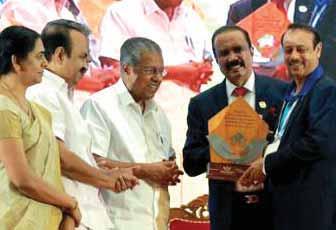
Kerala Chief Minister Pinarayi Vijayan felicitated PDG A V Pathy, RID 3201, for Rotary’s contribution in building houses for people who lost their homes in the 2018 floods that ravaged major parts of Kerala.
Soon after the deluge PRID C Basker launched ‘Project Hope’ to build houses for the flood victims, in partnership with Aster Group, a healthcare conglomerate. RID 3201, under then DG Pathy, had constructed 305 houses in the region. The project is being coordinated by Rtn Admiral Muralidharan.
Regn. No. TN/CCN/360/2018-2020
Licensed to post WPP No.TN/PMG(CCR)/WPP-431/2018-2020
Total number of pages in this monthly issue, including cover, 84. Price: `35
Registered with Registrar of News Papers for India 3880/57 Rotary News Published on the first week of every month
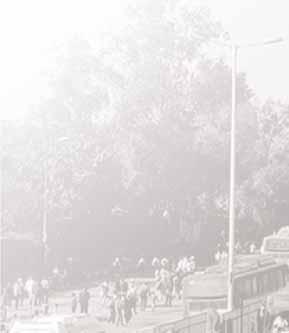


your





Make your online contribution at https://bit.ly/2UDBFDy or visit www.rotaryindia.org
Cheques can be made favouring Rotary India Humanity Foundation and sent to: Skyline House, 2nd Floor, 145, Sarat Bose Road, Kolkata 700 026, West Bengal.
Bank details


Dear Fellow Rotarians,
Bank : State Bank of India
Branch : Hazra Road, Kolkata.
A/C No. : 31317807754
IFS Code : SBIN0001649
The money sent by you will be forwarded to the PM Cares Fund in its entirety.


A/C Name : Rotary India Humanity Foundation

After making bank transfer, provide your details at www.rotaryindia.org under Fight against COVID-19 section or mail the following details to resource.mobilization@rihf.org:
• Transaction details: Amount, Date, NEFT, IMPS, RTGS number.
• Donor details: Name, address, contact number and email id. PAN number, if amount donated is `20,000 or more.
• District number and Club name.
• If you have contributed/or wish to contribute directly to the PM Cares Fund, in your payer details, apart from your company’s name, do mention your Rotary club and district. Then visit the www.rotaryindia.org website and upload details of your contribution — a picture of the cheque given or online transfer details. Rooad a




The COVID-19 pandemic has devastated India. The lockdown was necessary but has caused immense hardship to the poor and marginalised sections of our society, particularly the daily wage earner. The government is doing all it can but its coffers are stretched.






The senior leadership of India has discussed this pandemic and suggests that we Rotarians make a contribution of up to `25 crore to the PM Cares Fund. We urge each and every Rotarian to make a handsome contribution to help the government provide relief to the poor, create new healthcare facilities to deal with the infected, and above all, safeguard our healthcare workers, municipality/corporation and personnel with adequate protective gear. Together we can fight coronavirus. And together we will.









We definitely can do this if we stay, act and work together as a nation during this trying time.





Our country needs us at these trying times.


Apart from this, at our club levels, we urge Rotarians to provide whatever help and relief we can to those in need — by providing them groceries, cooked food, and other required supplies. Many of you are already doing great work; I appeal to you to do even more.
Shekhar Mehta Kamal Sanghvi Bharat Pandya
Rajendra Saboo Kalyan Banerjee Gulam Vahanvaty
Panduranga Setty Sushil Gupta Ashok Mahajan
Yash Pal Das P T Prabhakar Manoj Desai



C Basker Ravi Vadlamani A S Venkatesh
